User:Jimeee/Sandbox3/3
Daedric Princes[edit]
Contents
Azura[edit] |
||||||
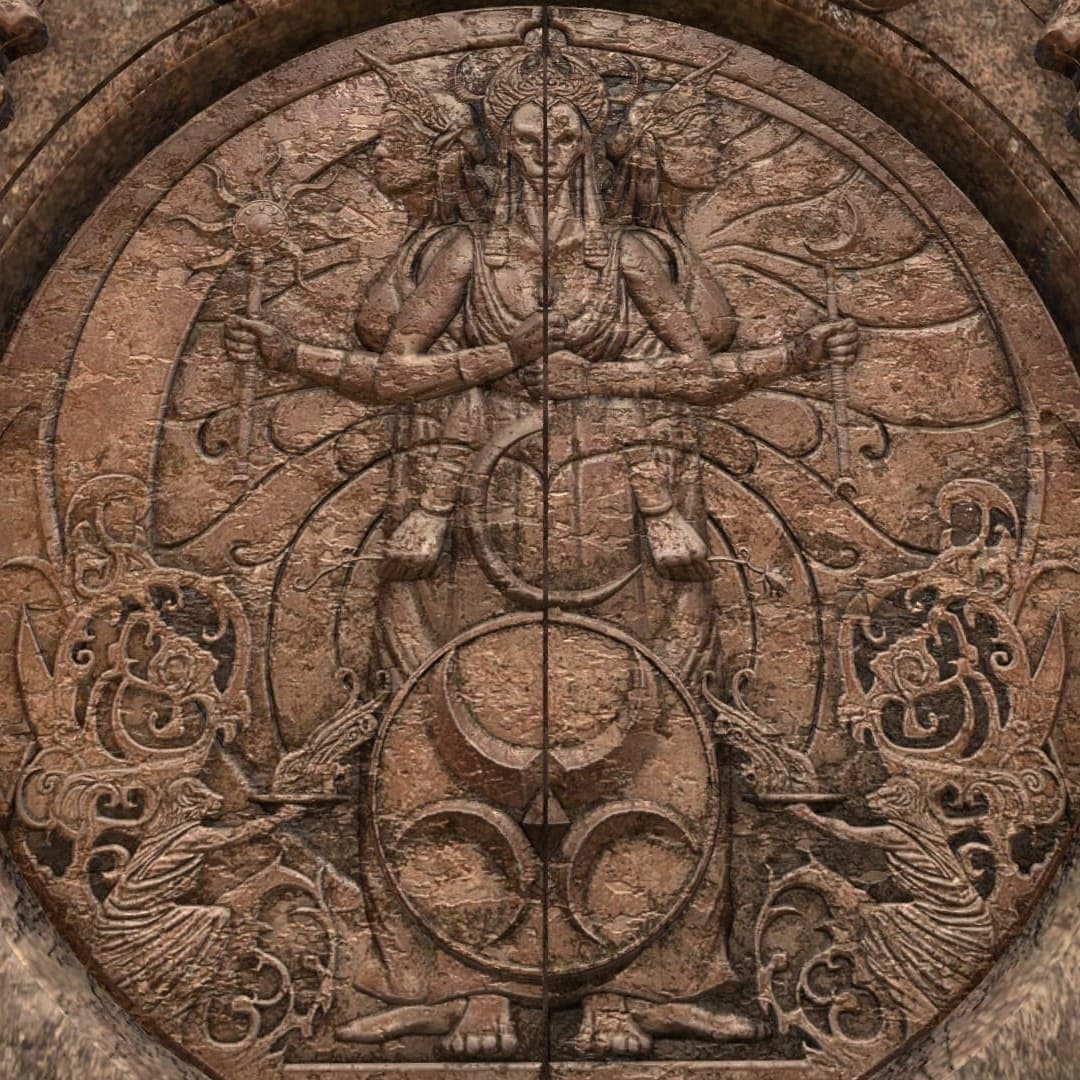 ESO ESO |
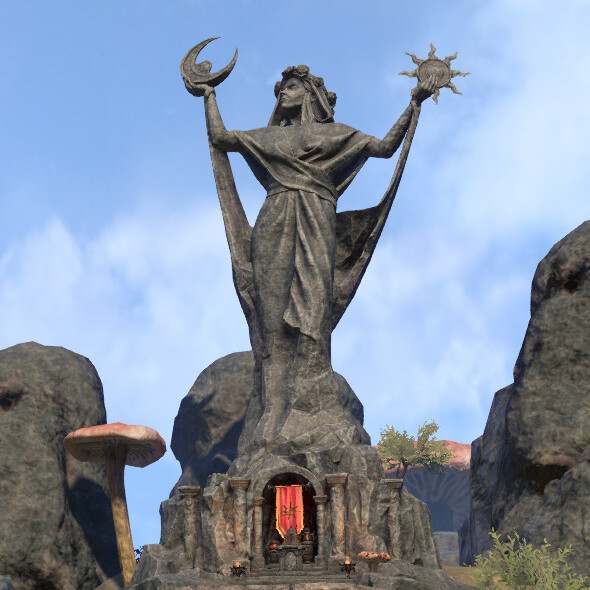 ESO ESO |
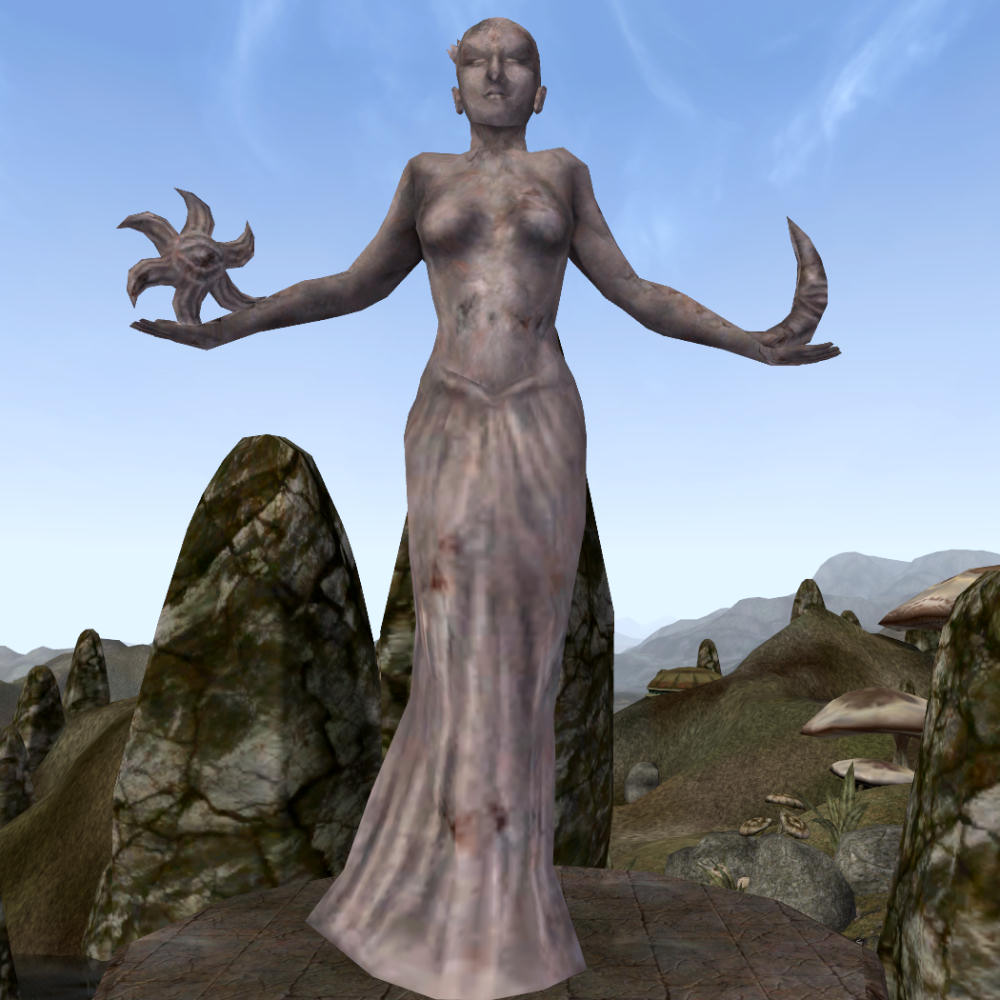 Morrowind Morrowind |
||||
|---|---|---|---|---|---|---|
|
A large gate of Azurah could be found in the Khajiiti temple of Ashen Scar in Elsweyr. It depicts the deity in her Khajiit, human and elven forms.[1] This type of relief was also featured on carved wooden blocks that could be found around the mid-Second Era.[2] |
A statue of Azura was erected on the south-eastern tip of Vvardenfell along Azura's Coast. It depicts Queen of Dawn and Dusk as a woman holding aloft a crescent moon in one hand and a star in the other. Inside the shrine a smaller statue of Azura could be found. Prior to the worship of the Tribunal in the First Era, the Chimer venerated Daedric Princes. As such, numerous statues and shrines were built across the land, although many of them fell into ruin. Azura's Shrine on the coast was one of the few that remained intact.[3] On occasion, Azura would communicate through the statue to speak to mortals and give them instructions.[4] |
|||||
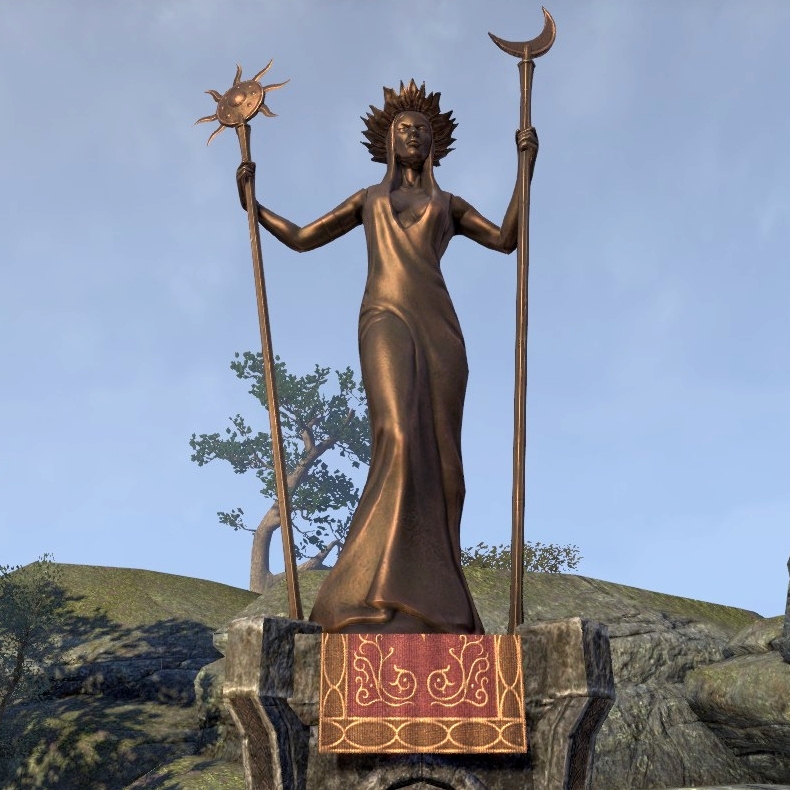 ESO ESO |
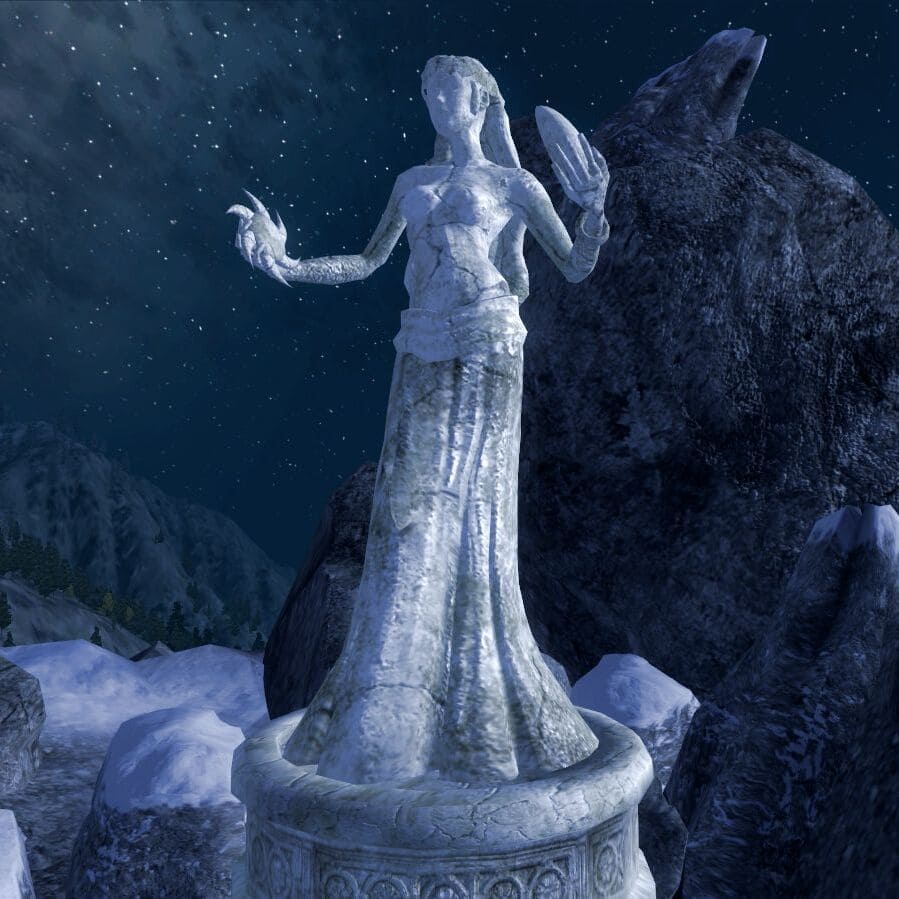 Oblivion Oblivion |
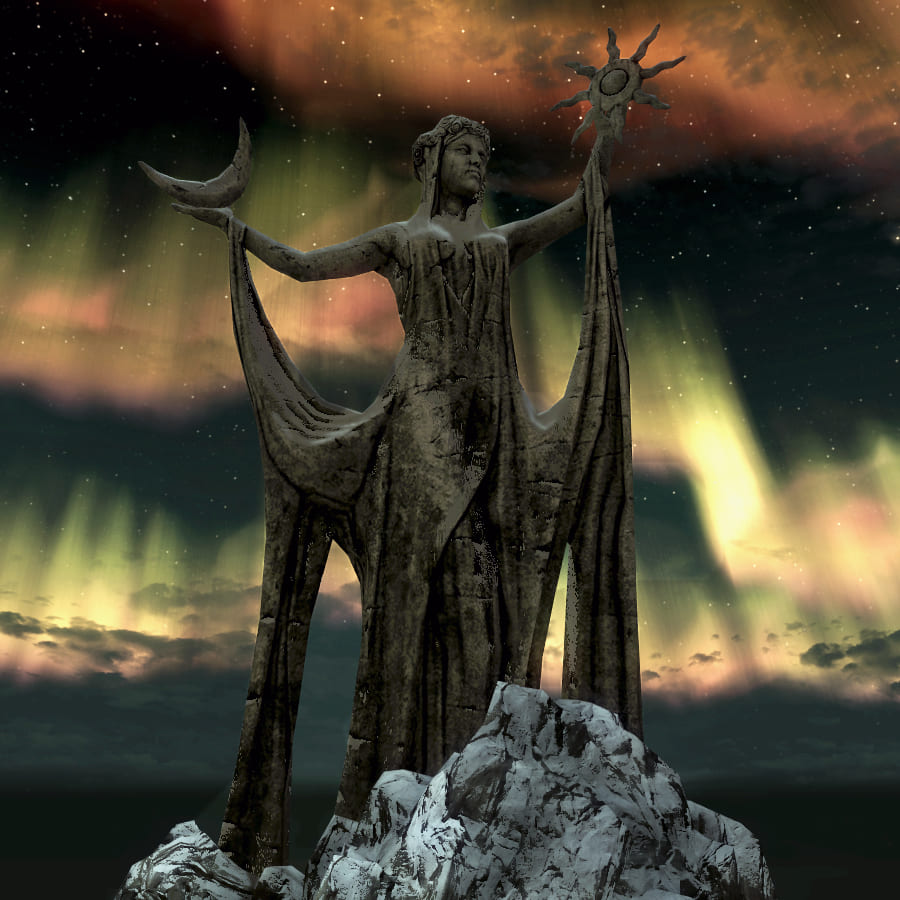 Skyrim Skyrim |
||||
|
The Spirit Wardens of Stormhaven were a group of Azura worshippers who built various statues of her, most notably in their abbey. The Wardens were founded by Abbot Durak, who was following Azura's instructions to found an order of worshippers and prepare for the time when Vaermina would strike the people of Stormhaven with a plague of nightmares.[5] The statue depicts Azura in a manner similar to Chimeri statuary found in Morrowind - as a woman holding two staves tipped with a crescent moon and a star.[6] On occasion, Azura would communicate through the statue to speak to mortals and give then instructions.[7] The monks at Pariah Abbey also made valuable Azurite figurines in her honor.[8] |
A statue of Azura could be found in the wilds of Cyrodiil during the late-Third Era. Located in the foothills of the Jerall Mountains, the statue depicts Azura in a similar manner as other statues and also served as a shrine for a small coven.[9] This shrine also allowed individuals to solicit the Daedra lord directly, provided they possessed sufficient prowess or strength of character, and provided a proper offering.[10][11] Although Daedra worship was not prohibited by law in Cyrodiil, public opinion was strongly against it to the extent that it was forced to be practiced in secret. This particular coven of Azura worshippers was known to some of the populace and were seen as relatively benign when compared to other Daedric cults.[12][13][10] |
An enormous statue of Azura was built in the mountains of Skyrim during the early-Fourth Era. The statue was erected by Dunmer migrants who fled Morrowind before the catastrophic Red Year took place. According to Azura's faithful, they were given a vision that led them away from Vvardenfell before the disaster. As a way of thanking Azura, her followers built a shrine dedicated to her near the peaks of Mount Anthor. Years later, Dunmer refugees were granted permission to settle in Skyrim after fleeing the aftermath of the Red Year.[14] Around 200 years later, all but one of Azura's followers abandoned the shrine, supposedly afraid to know their own future.[15] |
||||
Azura and the Cavern of the Incarnate[edit] |
|
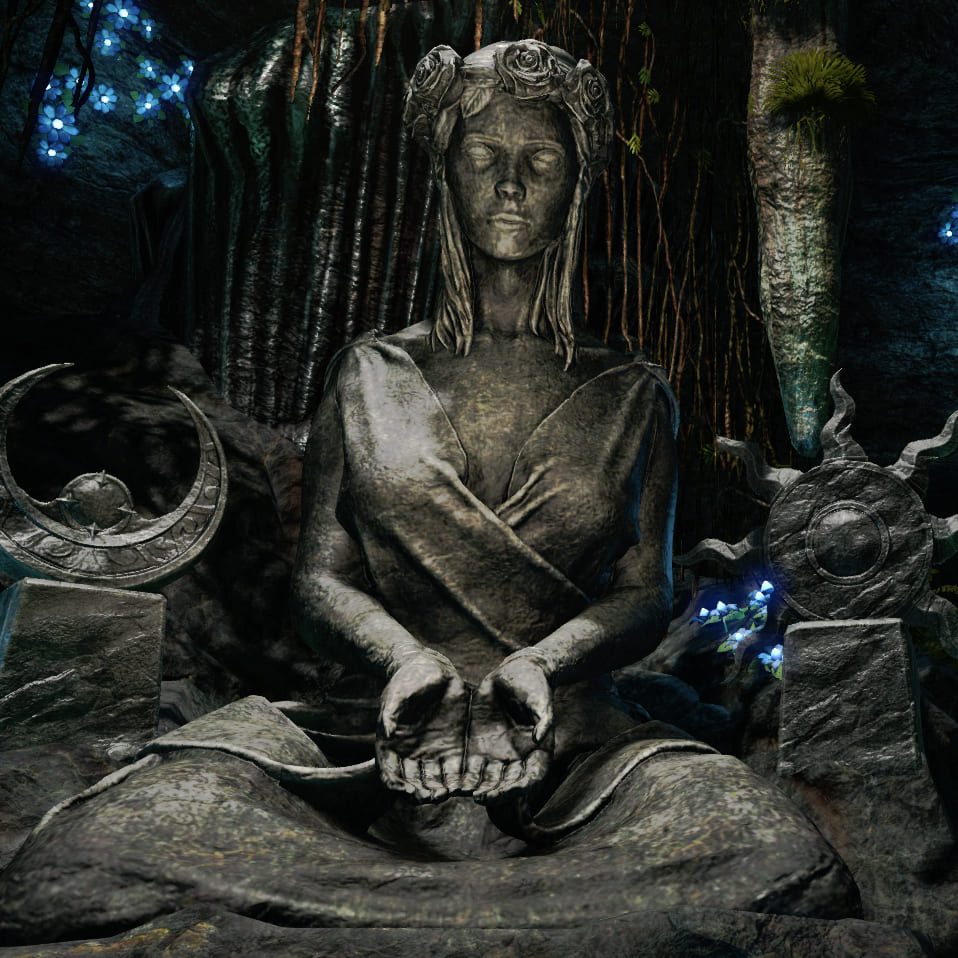 ESO ESO |
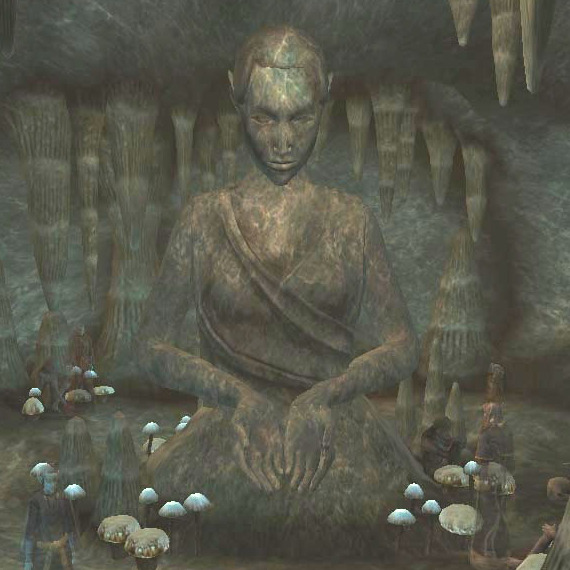 Morrowind Morrowind |
|---|---|
|
A large statue and shrine of Azura was erected in the Cavern of the Incarnate, the sacred resting site of Failed Incarnates located in the northern ashlands of Vvardenfell. Unlike other statuary, she is depicted sitting with her hands cupped.[16] Cavern of the Incarnate was notable as it was where Urshilaku wise women would commune directly with Azura through the shrine, particularly when they were required to render judgment on the claims of the numerous failed Neravarines over history.[17][18] |
|
Boethia[edit] |
||||||
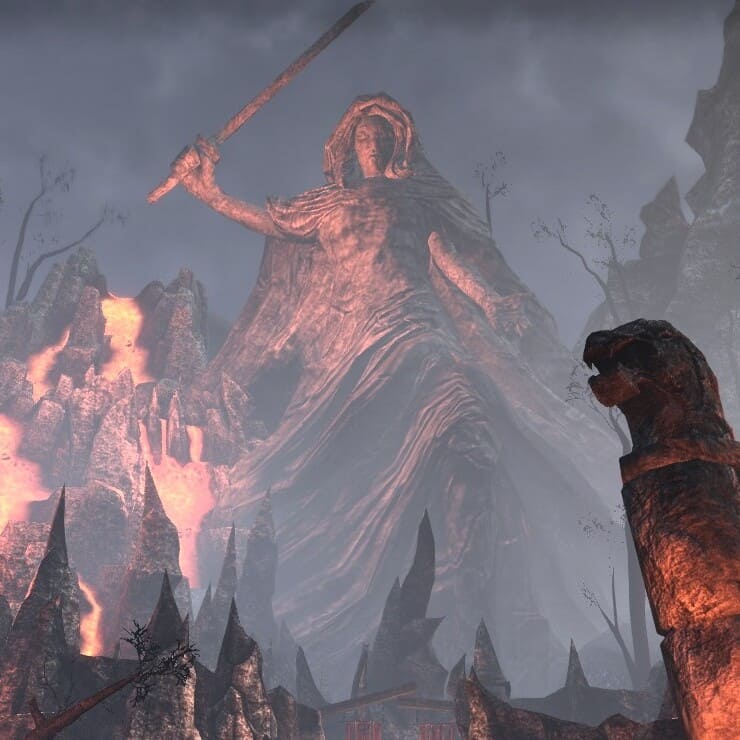 ESO ESO |
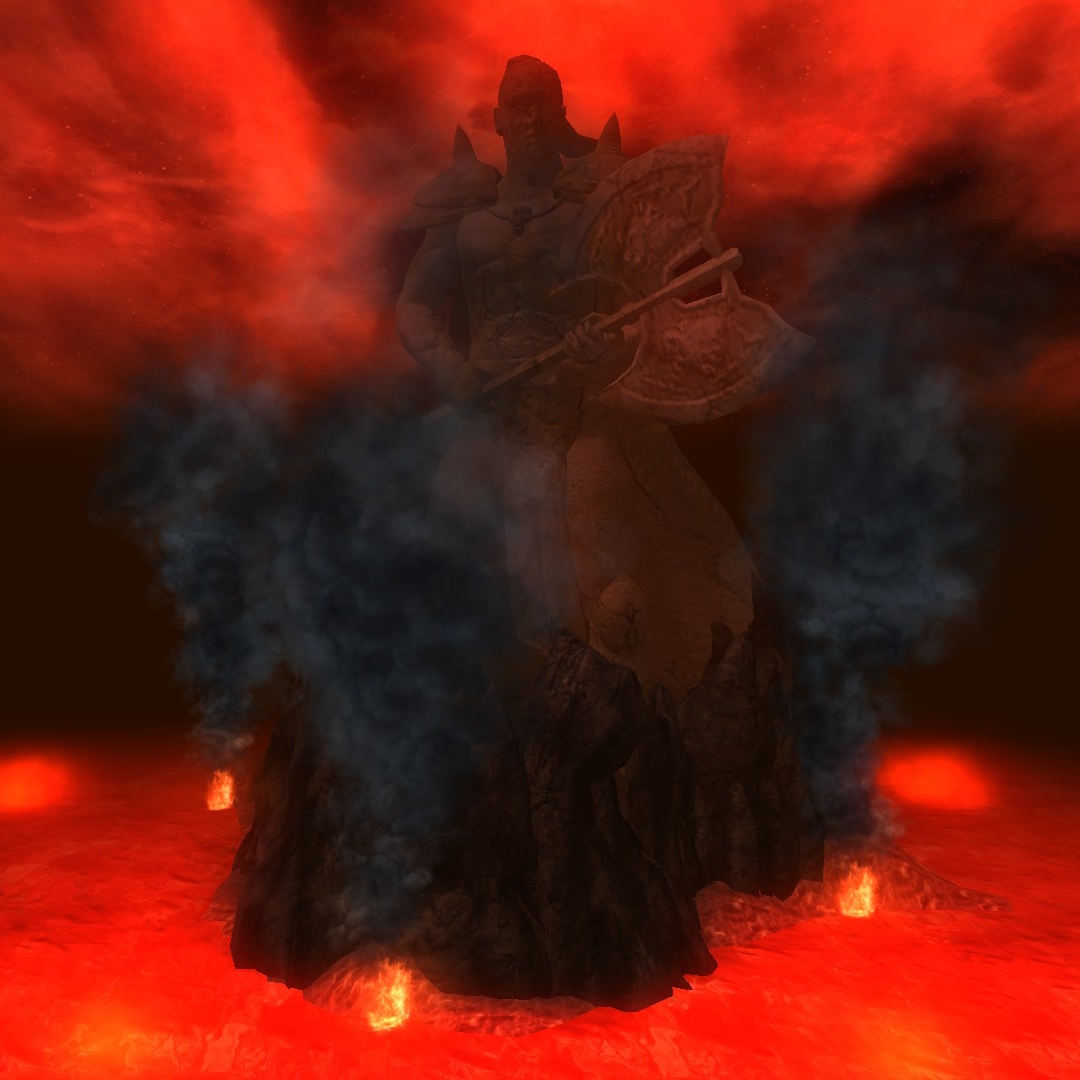 Oblivion Oblivion |
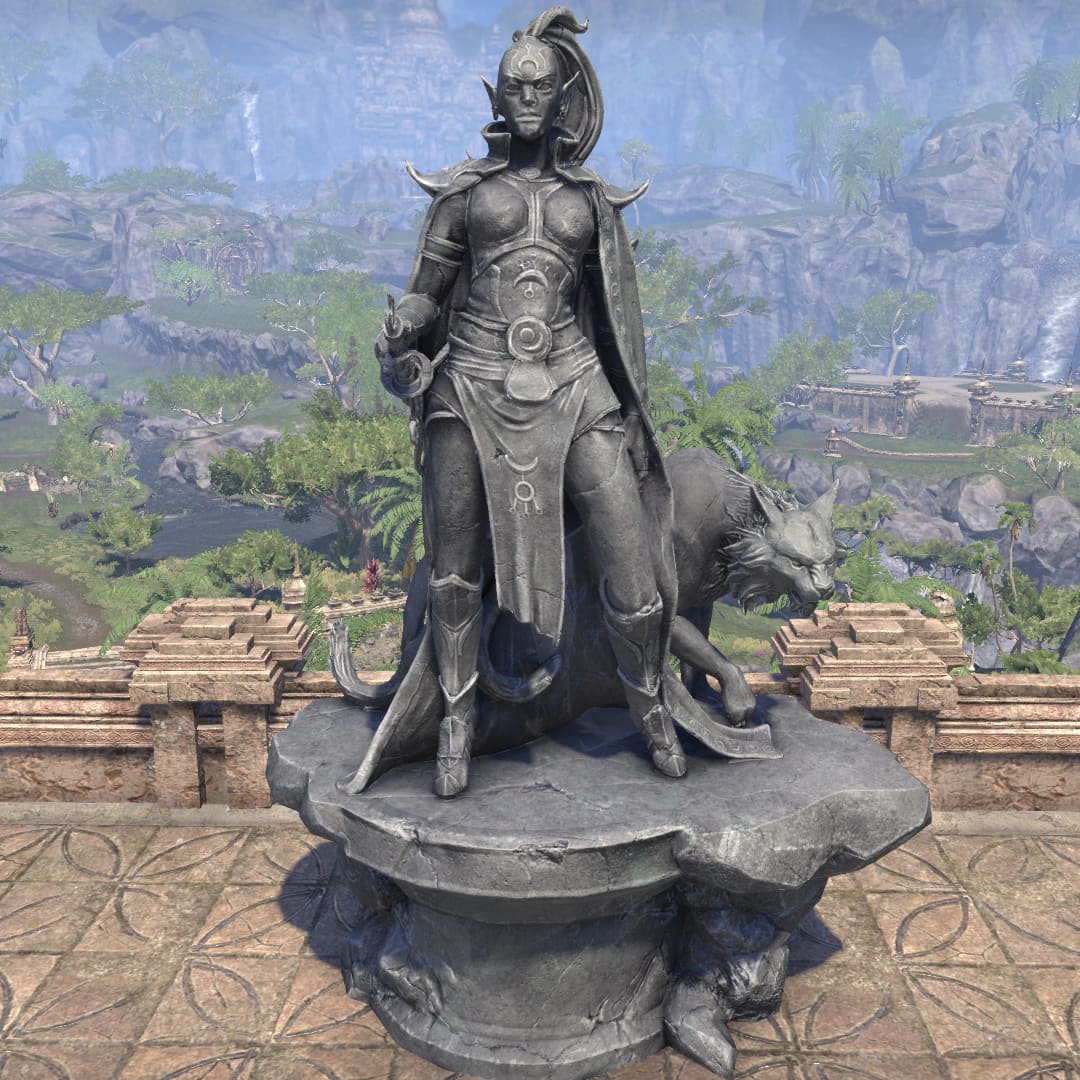 ESO ESO |
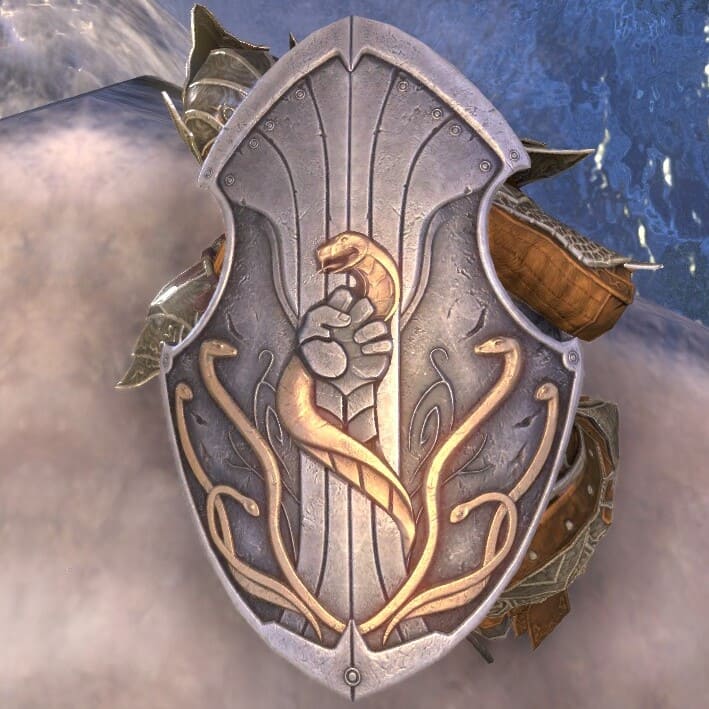 ESO ESO |
|||
|---|---|---|---|---|---|---|
|
Vast statues of Boethia could be seen in Attribution's Share, her realm of Oblivion. These statues were built in an arena where Boethia held the Tournament of Ten Bloods, so that mortals can earn her favor.[19] The ancient Nordic ruins near the city of Dragonstar was repurposed by followers of Boethia into Dragonstar Arena, and similar statues of her were built overlooking the combatants in various sections. The rough-hewn statues depict Boethia as either male or female while wielding a weapon.[20] |
A statue of Boethra, the Khajiiti variant of Boethiah, was uncovered in the mid-Second Era by the Antiquarian Circle in Elsweyr. The statue is believed to date back before the reunification of Elsweyr under the Elsweyr Confederacy and the emergence of the Riddle'Thar cult, during which various spirits and Daedra were venerated. Ancient Khajiit honored Boethra as a patron of warriors and rebellious exiles, and her statue bears these signs as she stands alongside a feline companion with a katana, cloak and her imperious expression.[21] |
Fearstruck was one of Boethia's artifact that bore serpent engravings, possibly in reference to the former name of her realm, Snake Mount.[UOL 1] The ebony shield was emblazoned with Boethiah's symbol of a fist surrounded by writhing golden snakes.[22] It belonged to Lyrisius, a hero famous for leading his army against the Akaviri slave traders. The shield was utterly destroyed in the First Era by the fiery breath of a wyrm who Lyrisius encountered after his army was routed.[23] |
||||
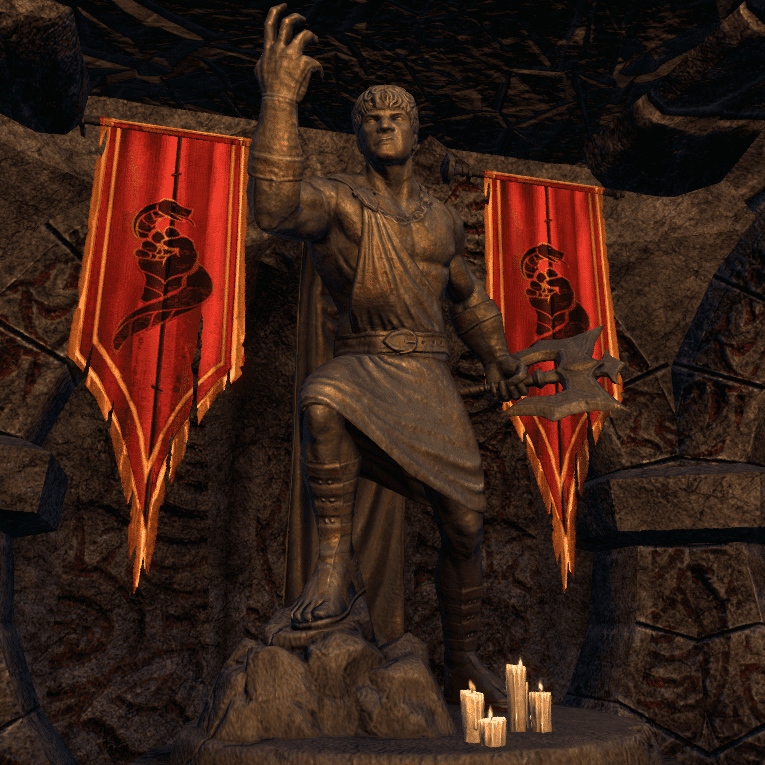 ESO ESO |
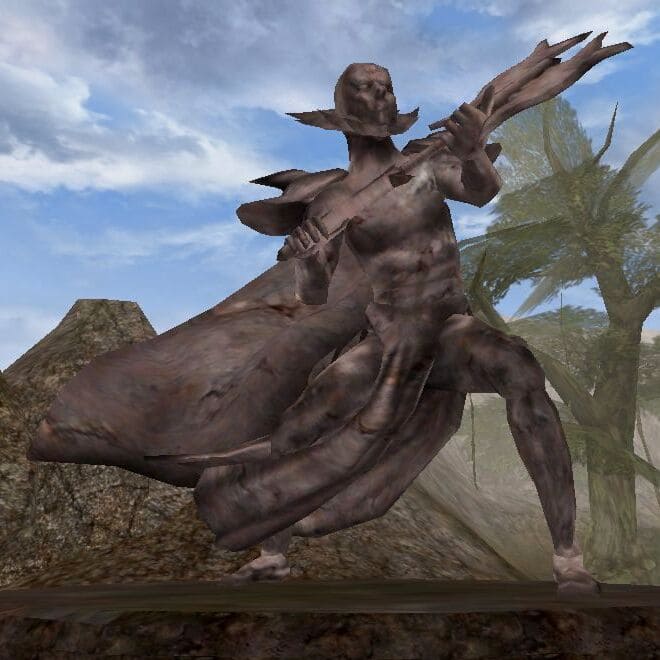 Morrowind Morrowind |
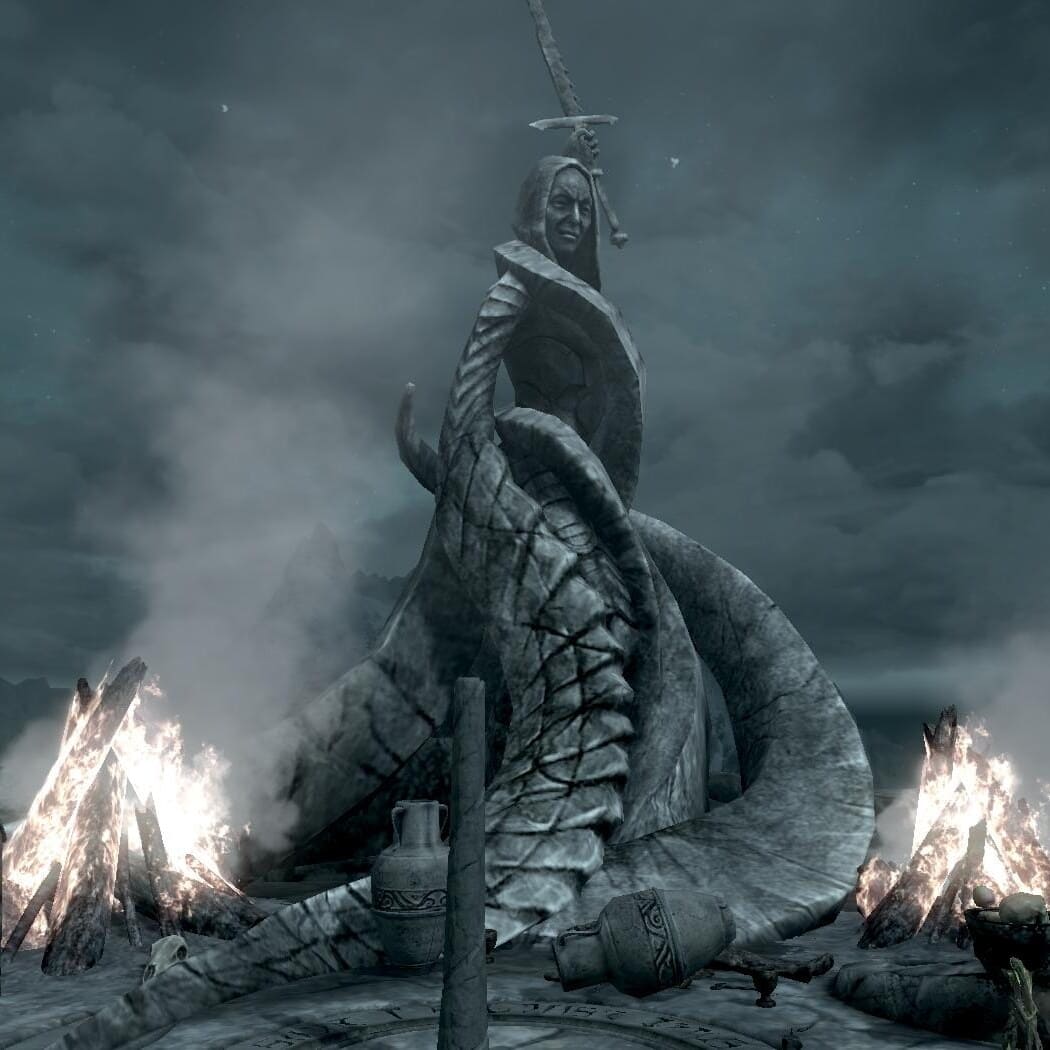 Skyrim Skyrim |
||||
| A depiction of Boethiah could be seen in a statue erected in Nisin Cave, in southwestern Cyrodiil during the mid-Second Era. Boethiah is depicted as a male and wears toga-like clothing while wielding an axe. During this time the cave was occupied by necromancers and Daedra.[24][nb 1] |
Dissatisfied that her shrine was in ruins and her priesthood had forgotten her, Boethiah convinced the Nerevarine to rebuild her statue on Vvardenfell.[25] The Nerevarine sought out Duma gro-Lag, a master sculptor who agreed to build the statue provided he was given a description of an ancient statue of Boethiah found in one of her holy books.[26][27] The sculptor eventually completed the statue in 3E 427 on the site of Khartag Point, which depicted a caped Boethiah wielding a large axe.[25] |
A statue of Boethiah could be found in the wilds of Cyrodiil during the late-Third Era. Although Daedra worship was not prohibited by law in Cyrodiil, public opinion was strongly against it to the extent that Daedra worshippers were forced to practice in secret or in secluded places.[10][28] Located high in the Valus Mountains, the statue depicts Boethiah in a similar manner as other statues, and also served as a shrine for a small coven.[29] This shrine also allowed individuals to solicit the Daedra lord directly, provided they possessed sufficient prowess or strength of character, and provided a proper offering.[10][30] |
A large statue of Boethiah could be found in Velothi Mountains in Skyrim during the early-Fourth Era. The statue depicts a hooded serpent-like Boethiah holding aloft her blade and was the central focus of a larger shrine dedicated to the Prince of Plots.[31] The shrine was occupied by numerous cultists who gathered to perform certain rituals on certain days, hoping to gain a glimpse of their master.[32] One ritual in particular involved testing the guile and conviction of Boethiah's faithful by luring and sacrificing an innocent soul upon a central pillar in the shrine.[33][34] |
|||
Clavicus Vile[edit] |
||||
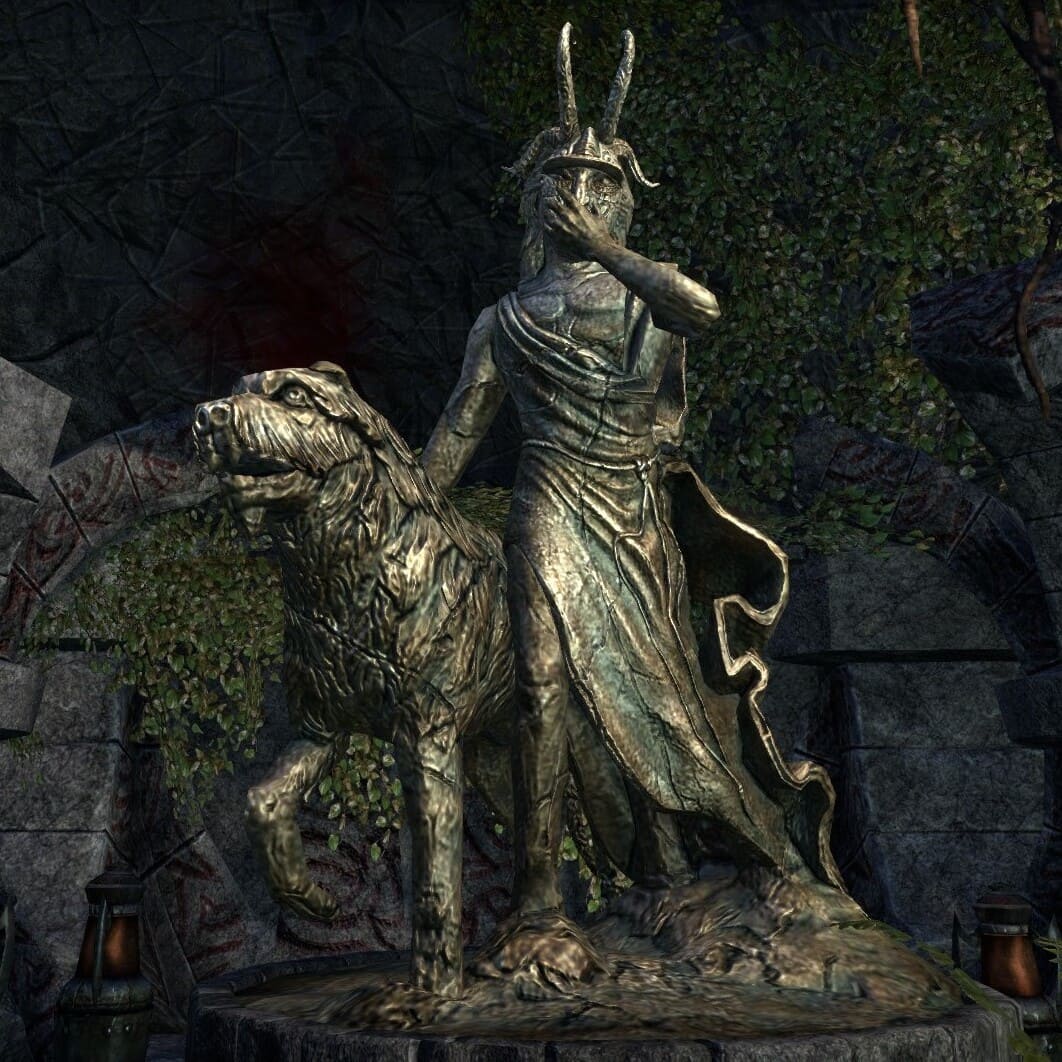 ESO ESO |
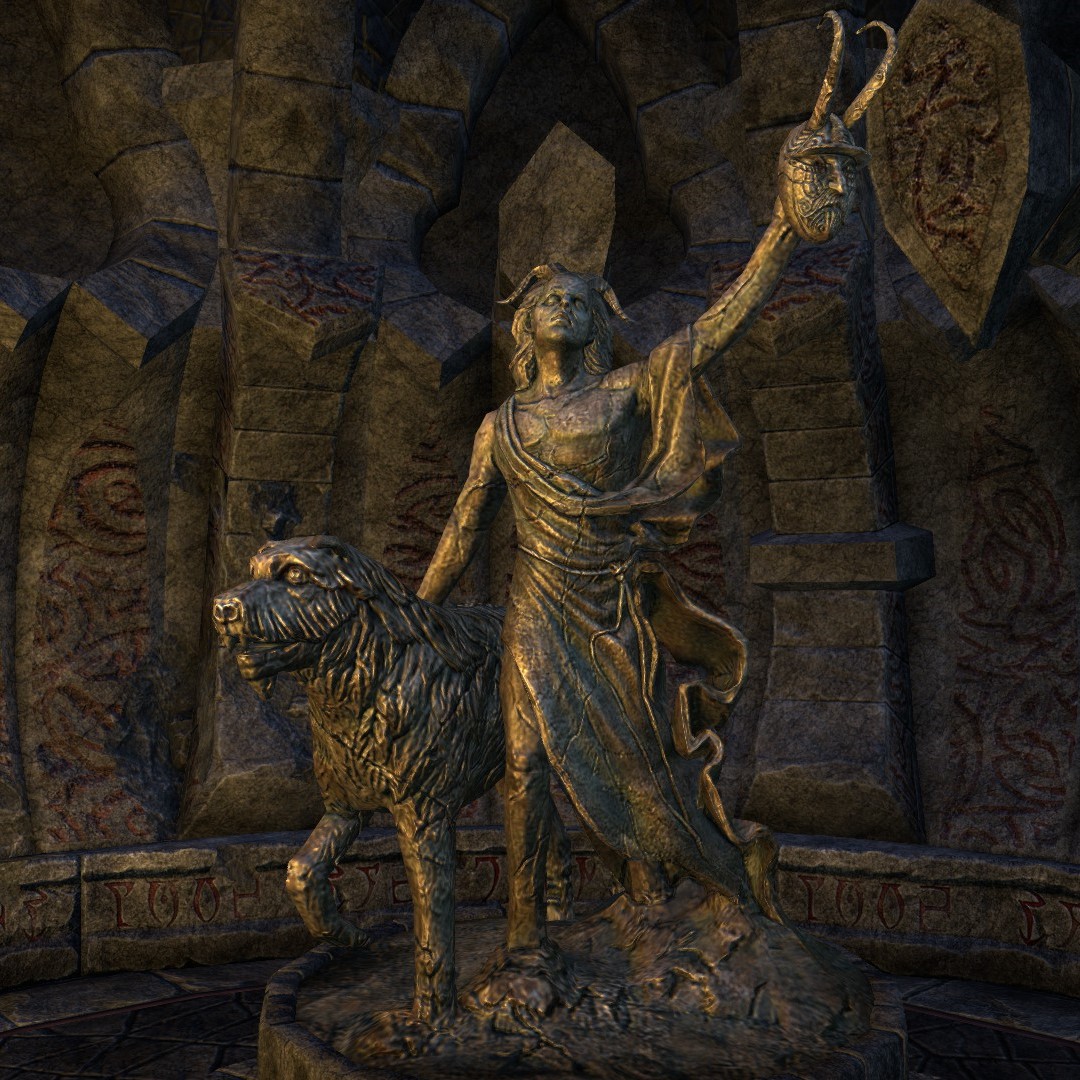 ESO ESO |
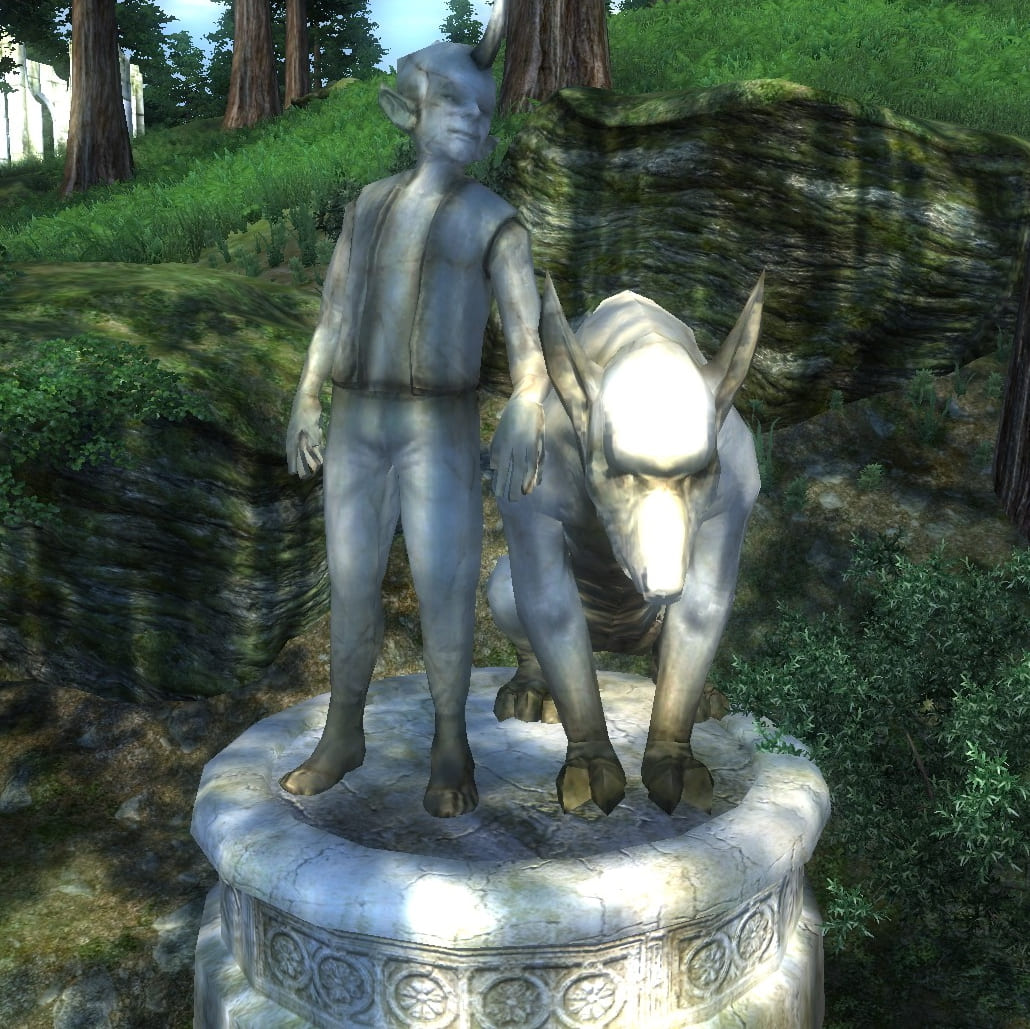 Oblivion Oblivion |
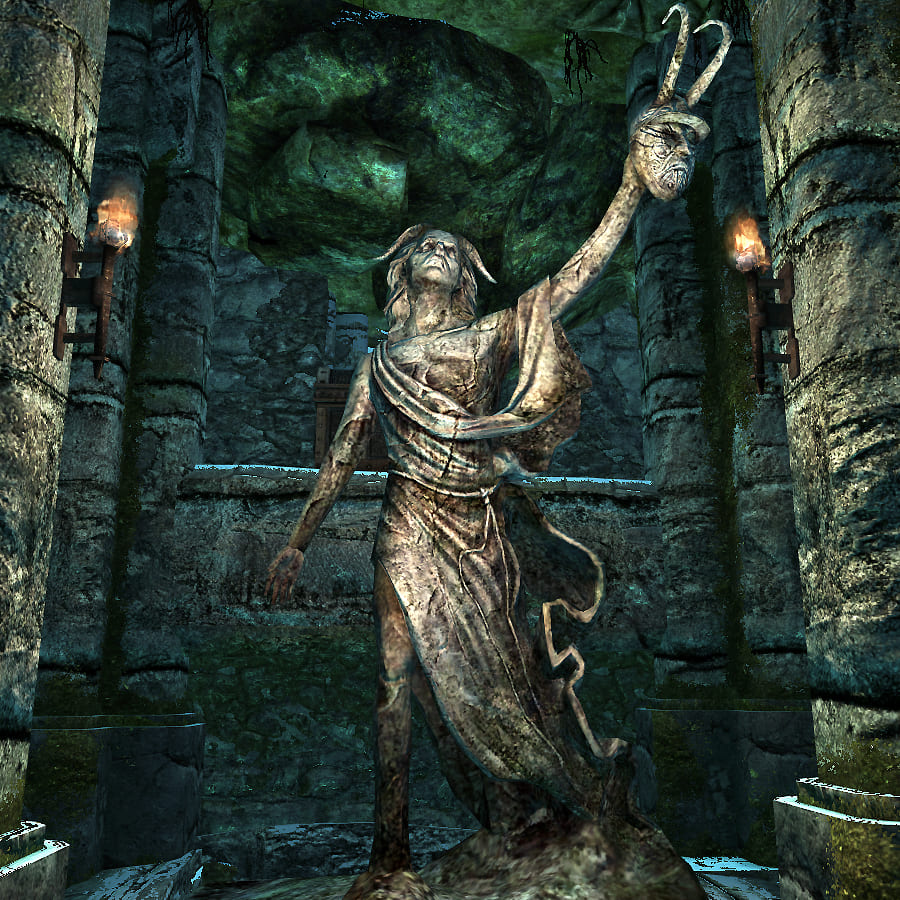 Skyrim Skyrim |
|
|---|---|---|---|---|
|
Statuary and other depictions of Clavicus Vile feature him either wearing or holding his infamous mask, but always include his loyal companion Barbas (who usually takes the form of a large hound) alongside him. Some of these depictions date back to the early Merethic Era in the form of crude, hand-carved idols or ancient cave paintings. Indeed, first-hand accounts detailing encounters with the Prince features Barbas in some capacity without exception. Such is the inseparable nature of these two beings that some Daedrologists believe Barbas and Clavicus Vile are one person in two forms.[35] When the Knahaten Flu swept through Black Marsh, the Kothringi of Stillrise Village uncovered an old temple to Clavicus Vile where a statue of him and Barbas could be found. In desperation, the Kothringi made a pact with the Prince of Bargains to save the village and grant them immunity to the sickness. In a twisted mockery of salvation, Clavicus Vile turned the entire village into undying skeletons.[36] Some of the villagers saw this as a curse, while others saw it as a blessing that made the perfect warriors.[37] |
A statue of Clavicus Vile and Barbas could be found in the wilds of Cyrodiil during the late-Third Era. Although Daedra worship was not prohibited by law in Cyrodiil, public opinion was strongly against it to the extent that Daedra worshippers were forced to practice in secret or in secluded places.[10] Located in the Great Forest, the statue depicts Clavicus Vile and Barbas in a similar manner as other statues and also served as a shrine for a small coven.[38] This shrine also allowed individuals to solicit the Daedra lord directly, provided they possessed sufficient prowess or strength of character, and provided a proper offering.[10][39] |
During the early-Fourth Era, the Last Dragonborn encountered a curious statue of Clavicus Vile in Skyrim. What set this statue apart from traditional depictions was that Vile stood alone, without his faithful companion Barbas. It was later revealed Clavicus Vile and Barbas had a disagreement, resulting in Barbas being exiled. Desperate to win back the favor of his master, Barbas aided the Last Dragonborn in recovering the Rueful Axe for Clavicus Vile.[40] The axe was recovered but the Last Dragonborn was given the option to use it to slay Barbas or return it to Vile, which would result in Barbas being restored to his position alongside Vile in the statue, however it is unknown which option was chosen.[40] |
||
Hermaeus Mora[edit] |
||
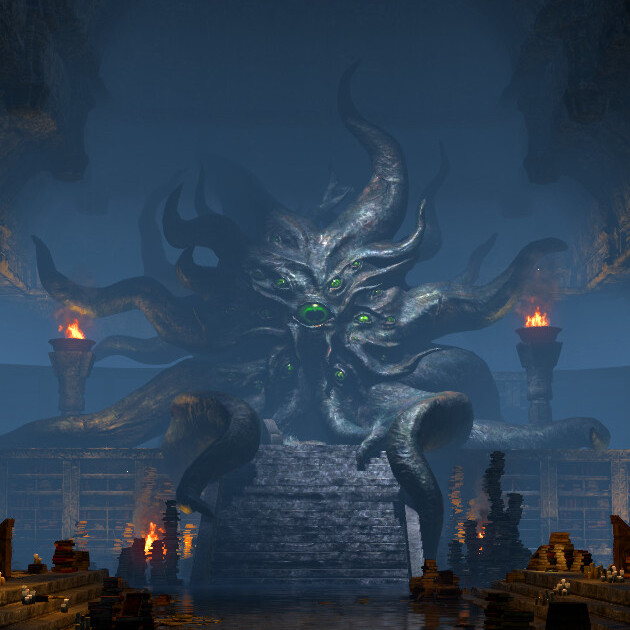 ESO ESO |
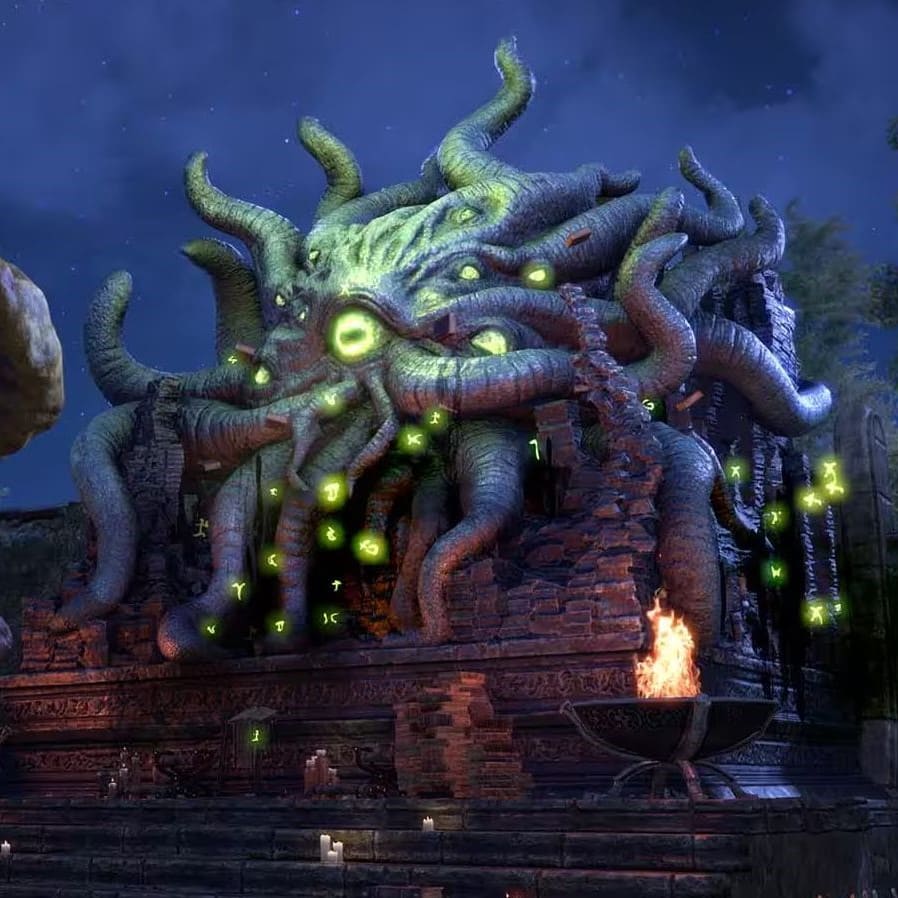 ESO ESO |
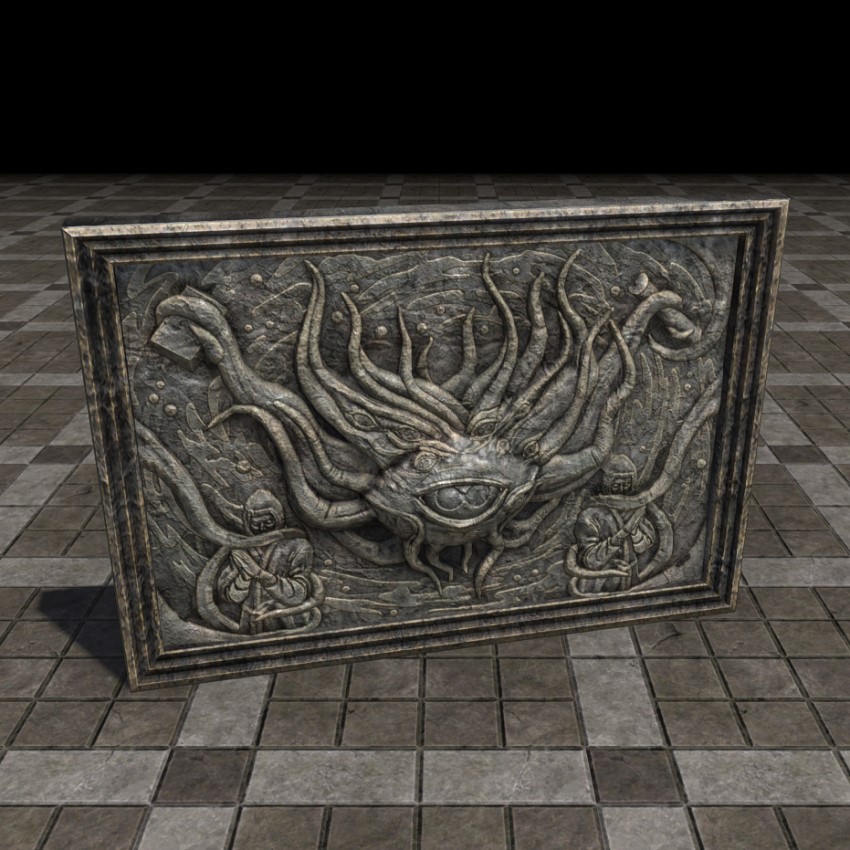 ESO ESO |
|---|---|---|
|
Statuary of Hermaeus Mora is unique in the fact that they are said to be access points from his realm of Apocrypha to Nirn.[41] On occasion, Hermaeus Mora would communicate through his statues to speak to mortals and give them instructions. Prior to the Third Era, Hermaeus Mora was typically depicted as mass of grotesque tentacles covered in eyes.[42][43][44] On occasion, he was represented by large metal orbs that were said to be modeled after his own golden eyes.[45] This depiction is believed to reach as far back as the First Era, where a vast statue and shrine of Hermaeus Mora was erected in Craglorn. Known as the Seeker's Archive, the shrine and library was built underground long before the Yokudans came to Hammerfell in 1E 808. This suggests that the Nedes native to Craglorn were possibly responsible for its construction. The followers of Hermaeus Mora who worshipped there were known as Seekers, and they brought gifts to the the Daedric Prince in return for secret knowledge. After the Yokudans slaughtered the natives, they built a temple over the shrine in order to defend it, but it was eventually forgotten about as the centuries passed.[46][47] |
||
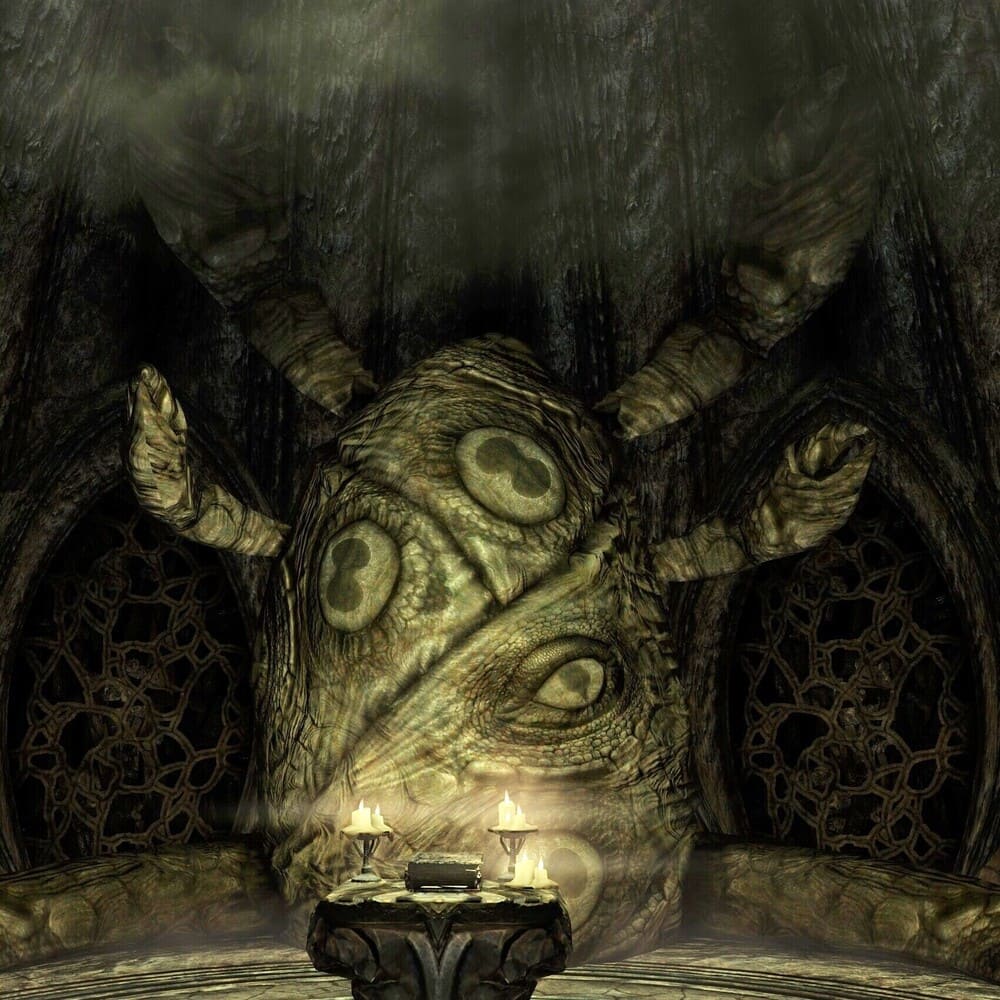 Skyrim Skyrim |
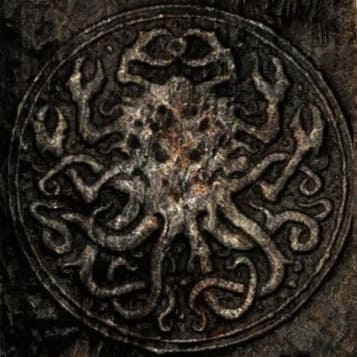 Skyrim Skyrim |
|
|
Around the Third and Fourth Eras, statuary and depictions of Hermaeus Mora were found to include four large pincers, alongside the mass of tentacles. The reason for this is unclear but is best illustrated in a large statue of Hermaeus Mora located high in the Jerall Mountains. The site also served as a secret shrine for a small coven of his worshippers.[48] This shrine also allowed individuals to solicit the Daedra lord directly, provided they possessed sufficient prowess or strength of character, and met certain criteria.[10][49] Other depictions discovered around this time include a large sculpture of Mora found in Miraak's Temple on Solstheim, which depicts him without tentacles entirely.[50] The cover of Mora's mysterious Black Books however are embossed with motifs of him bearing both tentacles and pincers.[51] |
||
Hircine[edit] |
|||
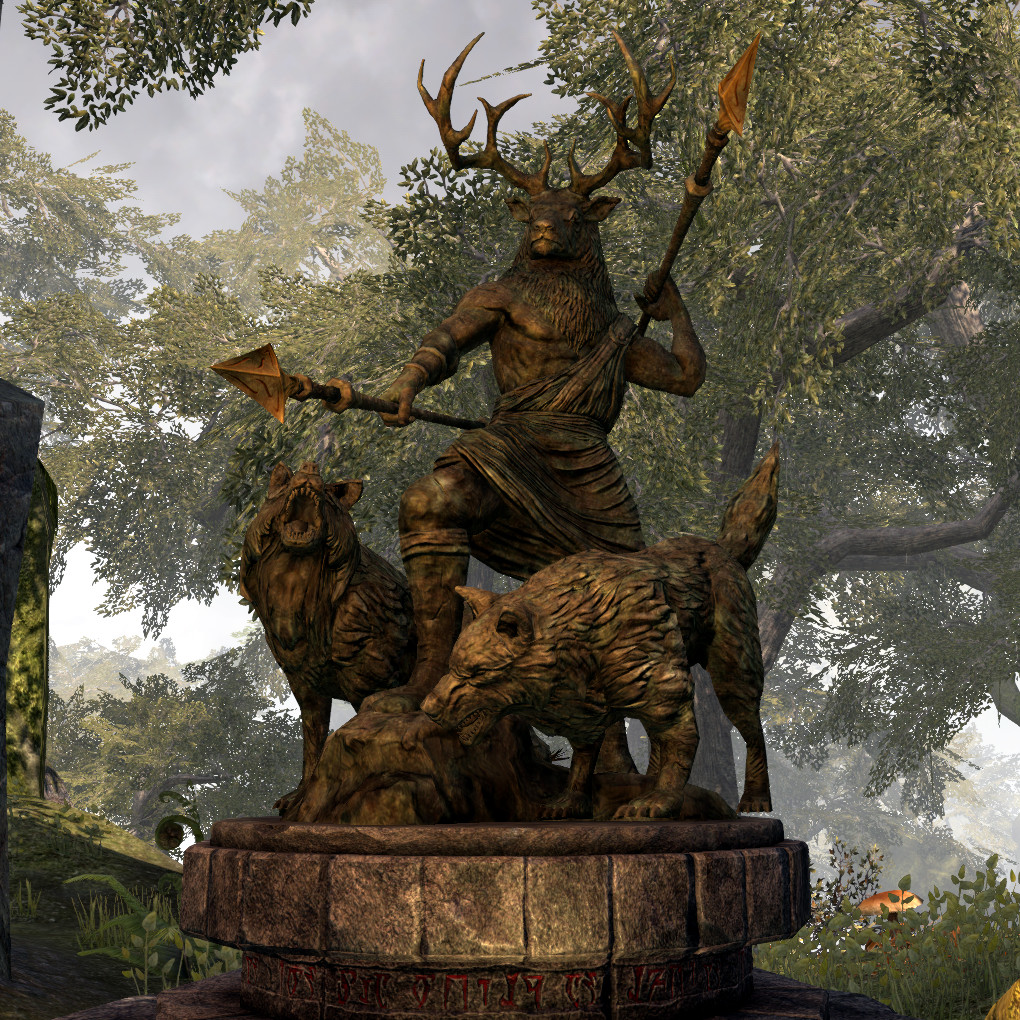 ESO ESO |
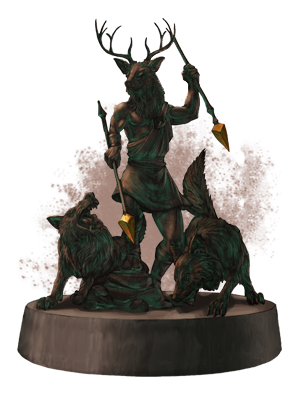 ESO ESO |
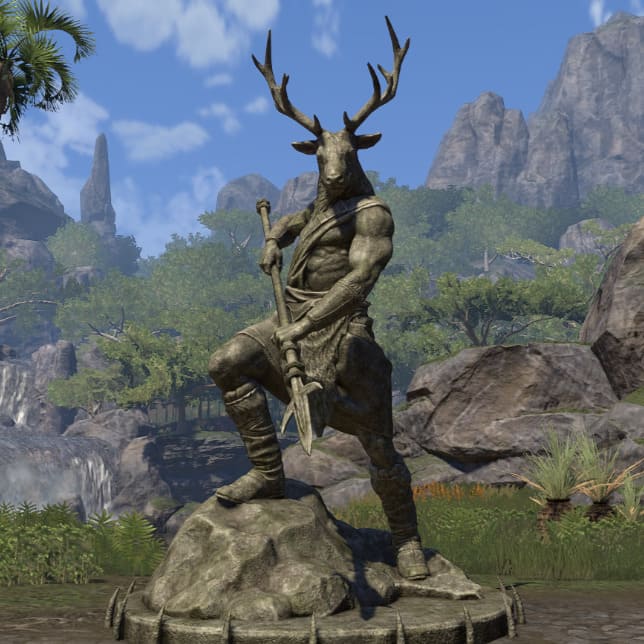 ESO ESO |
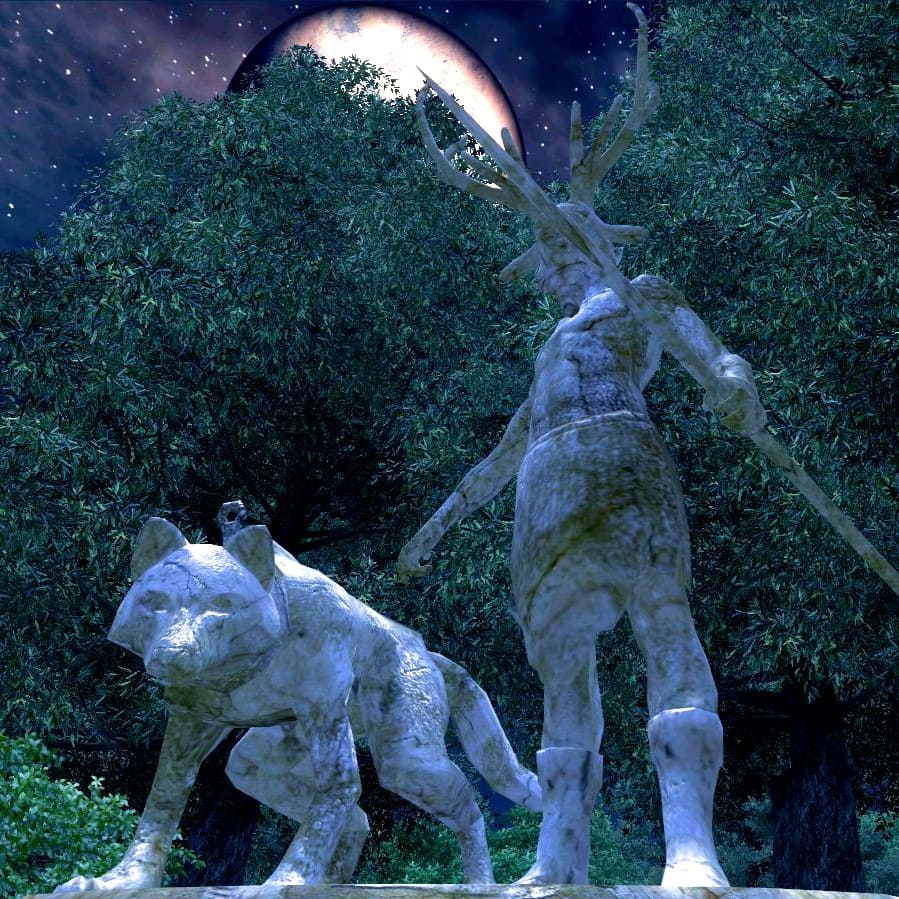 Oblivion Oblivion |
|---|---|---|---|
|
Statuary of Hircine always depicts him as Alrabeg the Hunter, one of his many aspects. When Alrabeg manifests, he bears the Spear of Bitter Mercy,[52] or sometimes the Spear of the Hunter.[53]. As such, his statuary, figurines, and idols reflect this as he is typically depicted wielding his spears while clothed in furs and a large antler headdress and sometimes flanked by wolves.[54][55] This was evident in Reachman statuary, given that Hircine is widely worshipped in their pantheon and Alrabeg is seen as his most malevolent form. These statues served as shrines and altars, and played a part in Reachman hunting rituals.[56] A notable example of this is in the Shrine of the Hunt-Father in Markarth, where a large statue of Hircine was erected during the mid-Second Era.[57] Though the Dunmer primarily worship the Good Daedra and recognize the House of Troubles as obstacles, some dissidents erected statues in worship of Hircine in Dunmer lands during the mid-Second Era. Examples include the statue of Hircine present at Heimlyn Keep,[58] or a shrine to the Huntsman in the ruins of Ularradallaku.[59] In the Bosmer village of Wilding Run, a large statue of Hircine was found at its center.[60] It was believed to be associated with Ulthorn, who came under the influence of Hircine and became known as the Hound. Ulthorn returned to his hometown of Wilding Run and wiped out the local populace as he hunted them for sport.[61][62] |
A statue of Hircine could be found in the wilds of Cyrodiil during the late-Third Era. Although Daedra worship was not prohibited by law in Cyrodiil, public opinion was strongly against it to the extent that Daedra worshippers were forced to practice in secret or in secluded places.[10] Located in the Great Forest, the statue depicts Hircine in a similar manner as other statues, and also served as a shrine for a small coven.[63] This shrine also allowed individuals to solicit the Daedra lord directly, provided they possessed sufficient prowess or strength of character, and provided a proper offering.[10][64] |
||
Malacath[edit] |
|||
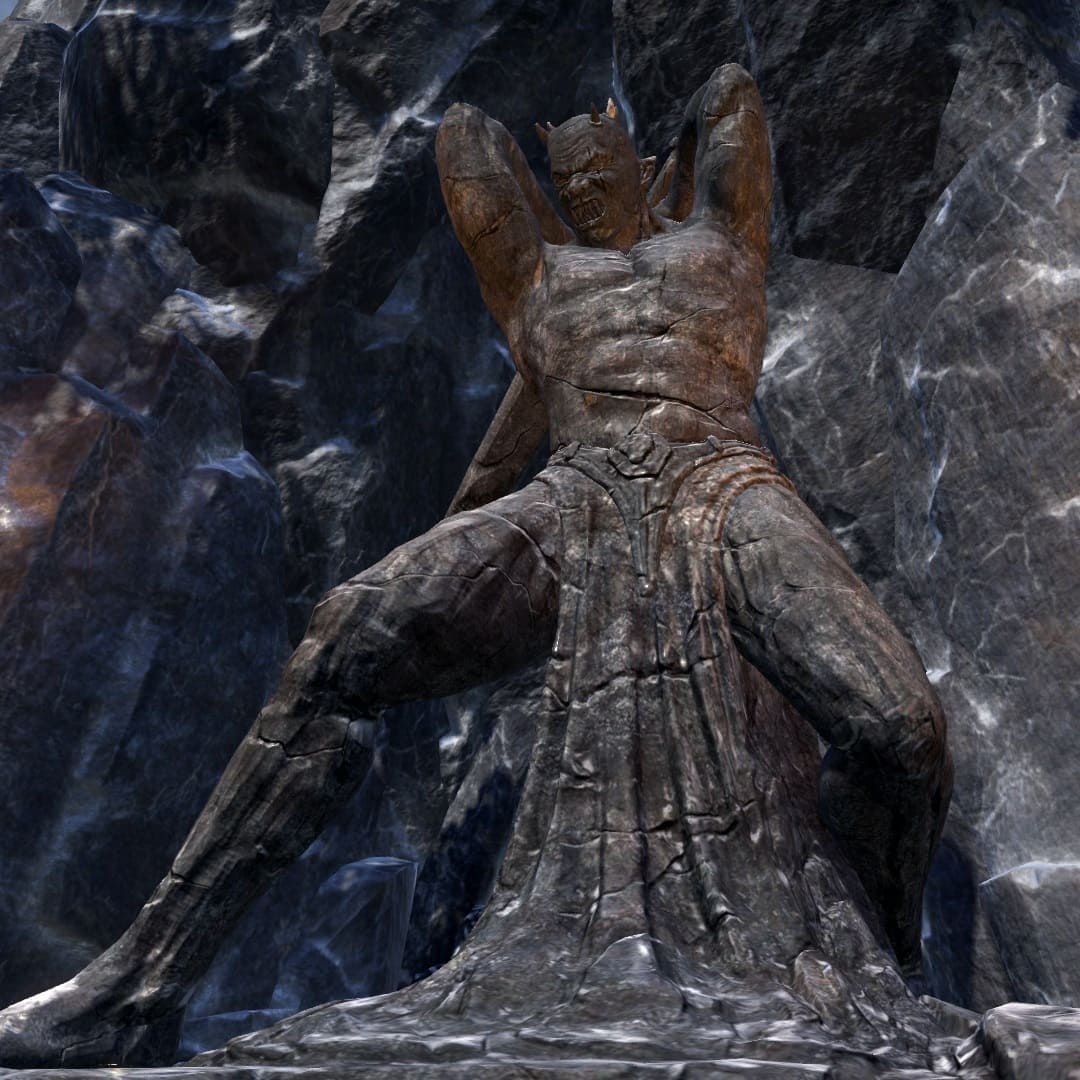 ESO ESO |
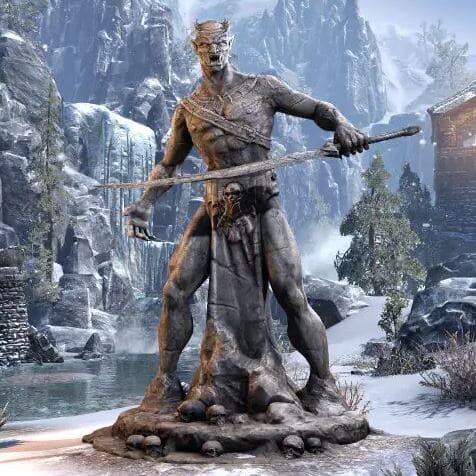 ESO ESO |
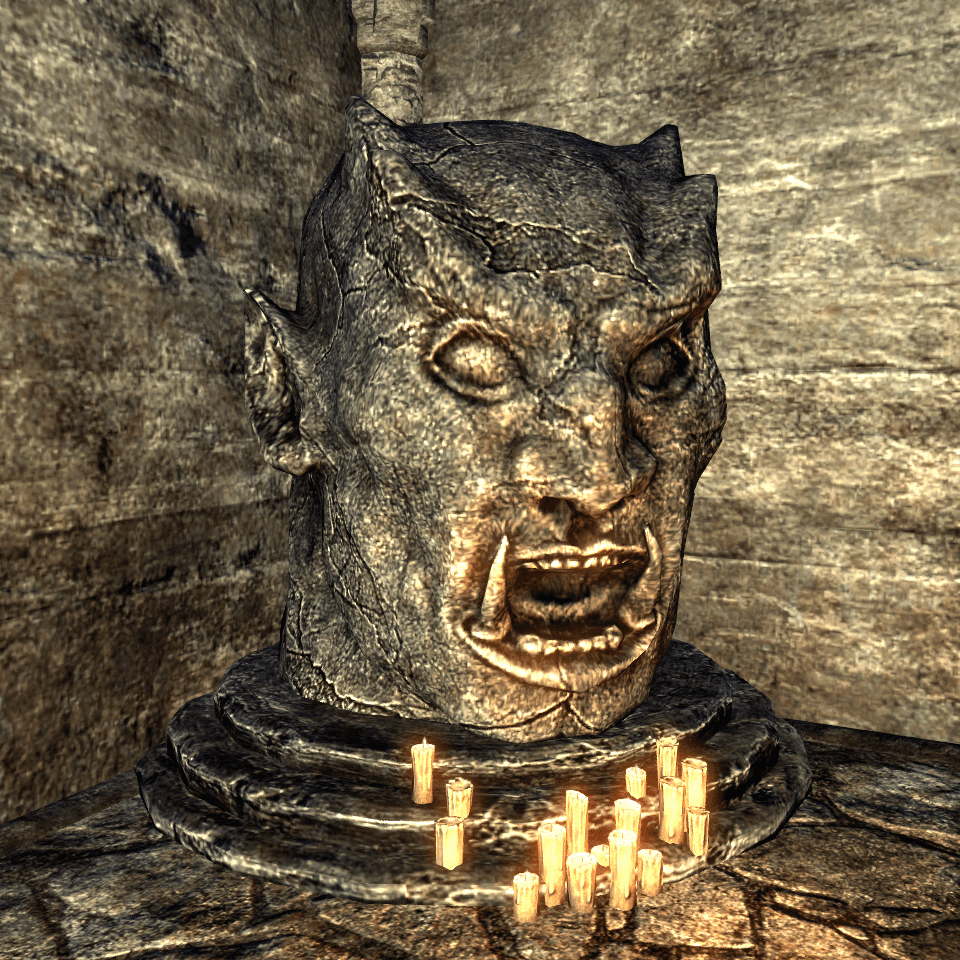 ESO ESO |
|
|---|---|---|---|
|
Statuary of Malacath could be found throughout Wrothgar during the mid-Second Era, and typically depicted him wearing a loincloth and wielding a sword. Despite attempts to replace the worship of Malacath with Trinimac during this time, the most notable statue of him was found in the Druadach Mountains, where a vast shrine and forge stood.[65] Some Orcs displayed statuettes of Malacath in their home to remind others of the importance of grudges and the cost of vengeance.[66] Stone idols and totems also depict the Keeper of the Bloody Curse, and some Orcs are known to repeatedly apply blood to them, resulting in them taking on a rust-brown color.[67] The stone of some statuary found around this time appeared heavily chipped and cracked, leading some scholars to speculate if this disfigurement was possibly not from neglect, but rather blasphemy, or even devotion.[68] The Seamount Clan Orcs were known to craft heavy, wrought-iron statues that depict Mauloch in battle and were used as table centerpiece in their dwellings.[69] |
|||
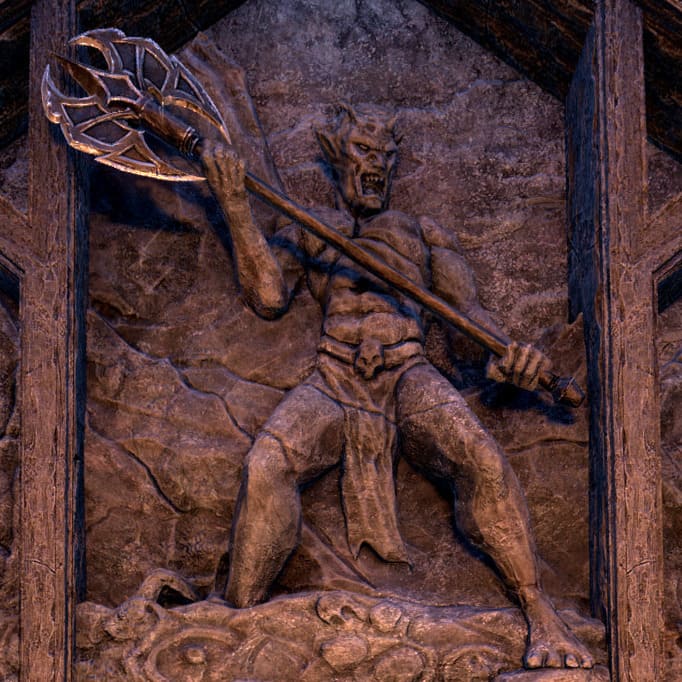 ESO ESO |
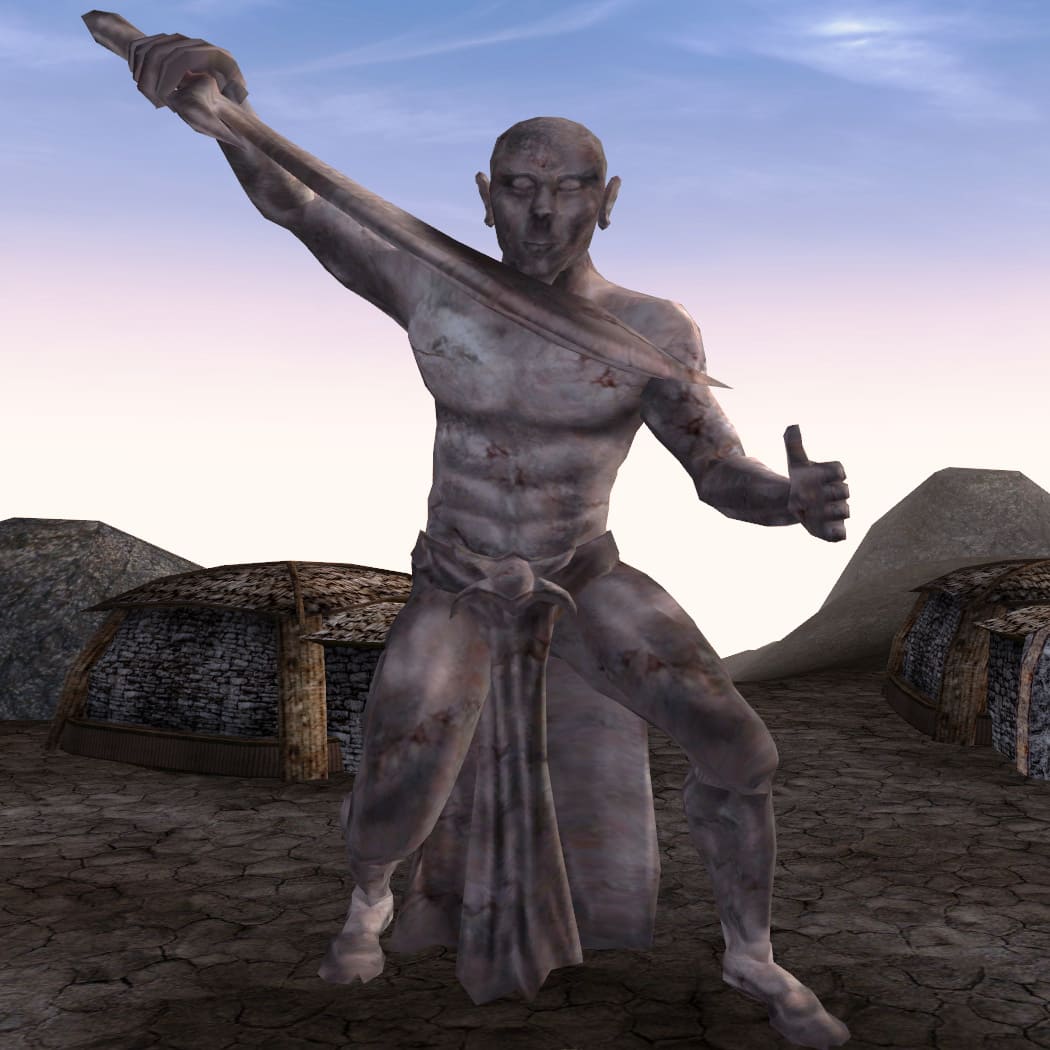 Morrowind Morrowind |
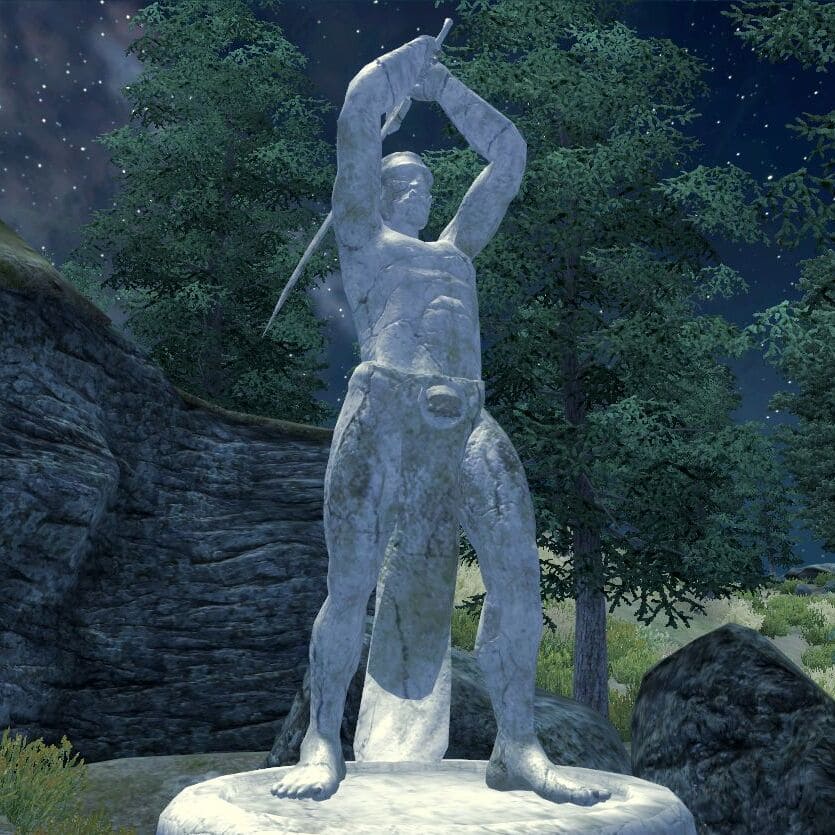 Oblivion Oblivion |
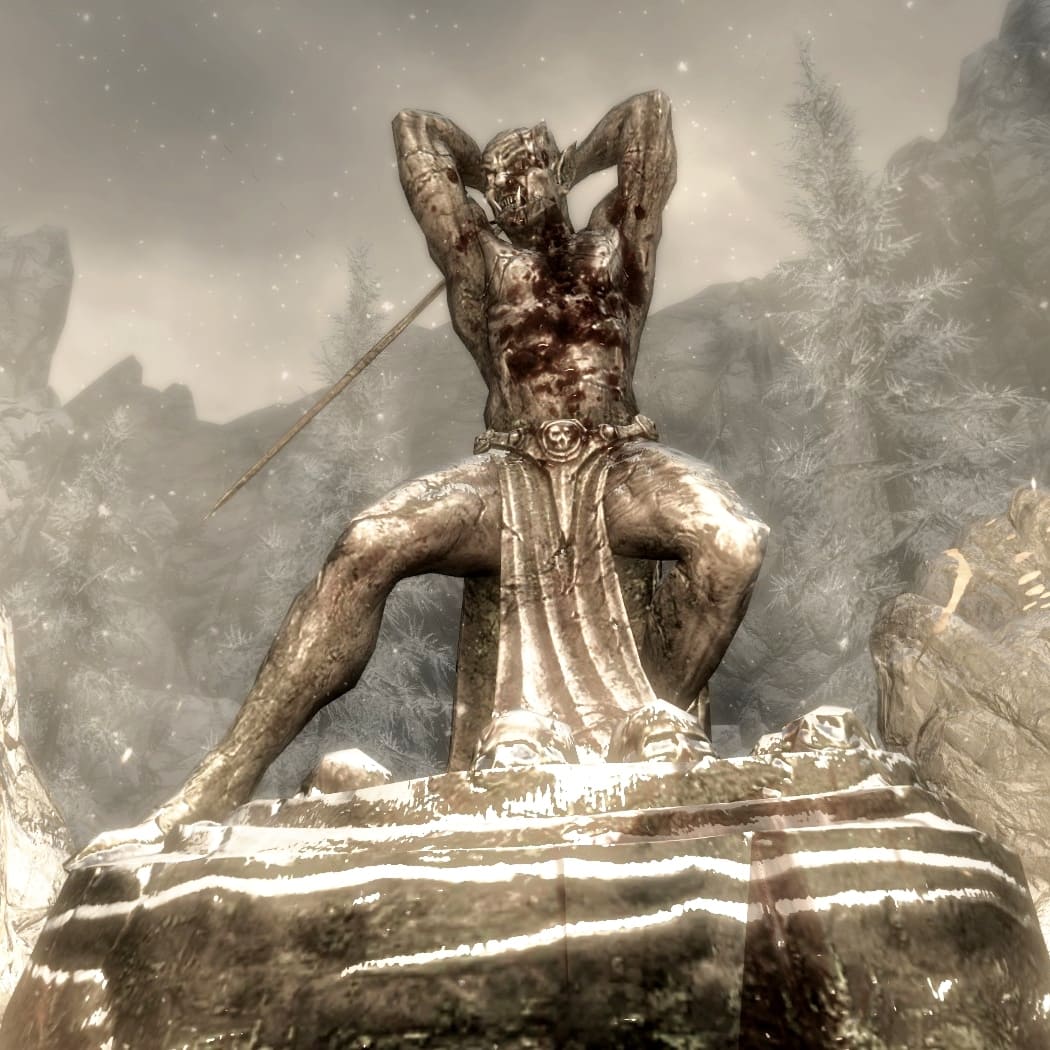 Skyrim Skyrim |
|
A large high-relief statue of Malacath was built deep in the halls of the original Orsinium. The statue was notable as it depicts Malacath wielding a Scourge-like battleaxe, instead of a sword.[70] The statue also served as a shrine which overlooks a vast pyre. An Orcish religious order known as the Wrathful Flame considered the pyre sacred and was devoted to rekindling the pyre every generation. According to their doctrine, the pyre fuels vengeance in the hearts of Malacath's followers as they bind his anger to their failures and strive to remember what led to their doom.[71][72] |
During the late-Third Era, numerous statues of Malacath could be found across Vvardenfell, including the Daedric ruins of Ashunartes, Dushariran, Kaushtarari, and others. As the First Corner of the House of Troubles, Malacath was seen as an adversarial god to the Dunmer and is believed to test them for weakness.[73] Those who sought to become the Archcanon of the Temple were required to travel to the Malacath's statue on Dagon Fel and recite Vivec's "Four Corners of the House of Troubles".[74] |
A statue of Malacath could be found in the wilds of Cyrodiil during the late-Third Era. Although Daedra worship was not prohibited by law in Cyrodiil, public opinion was strongly against it to the extent that Daedra worshippers were forced to practice in secret or in secluded places.[10] Located in the Gold Coast, the statue depicts Malacath in a similar manner as other statues and also served as a shrine for a small Orcish coven.[75] This shrine also allowed individuals to solicit the Daedra lord directly, provided they possessed sufficient prowess or strength of character, and provided a proper offering.[10][76] |
A large statue of Malacath was erected in a hidden grove found deep in the valleys of the Velothi Mountains in Skyrim.[77] It was almost identical in appearance to the vast shrine of Malcath found in the mountains of Wrothgar during the mid-Second Era.[65] The statue served as a shrine for the Orcs of Largashbur, but during the early-Fourth Era the site was overrun by a group of giants, who defiled the shrine. Furious that the chief of Largashbur was weak enough to allow this to occur, Malacath cursed the Orcish tribe until such a time they could prove their worth.[78] |
Mehrunes Dagon[edit] |
|||
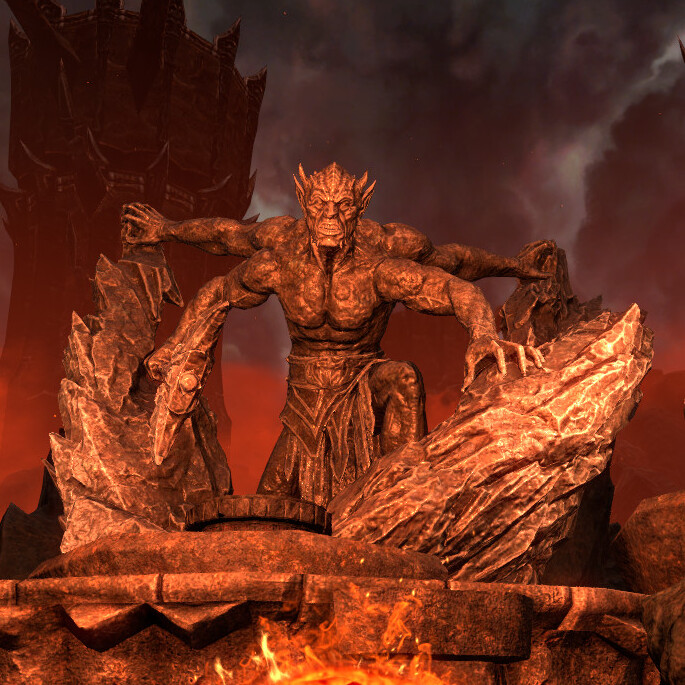 ESO ESO |
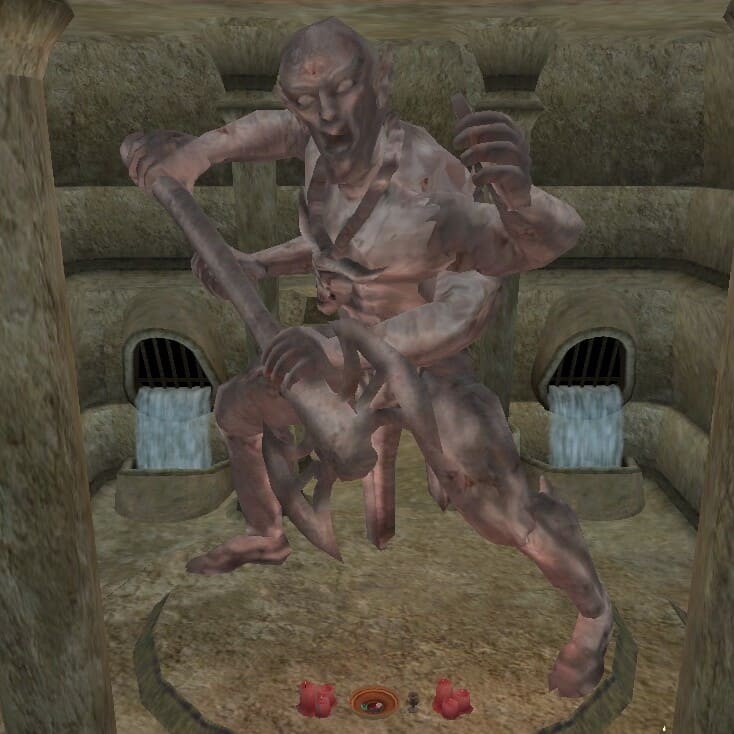 Morrowind Morrowind |
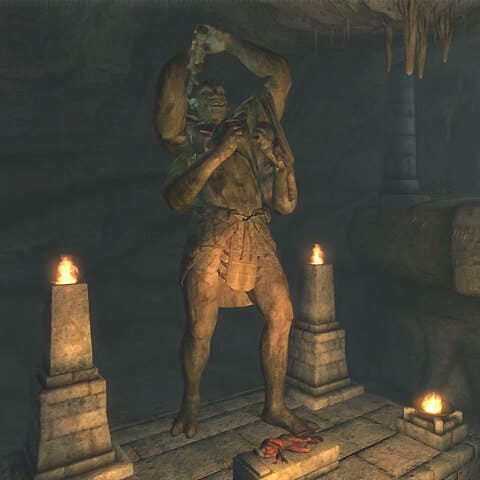 Oblivion Oblivion |
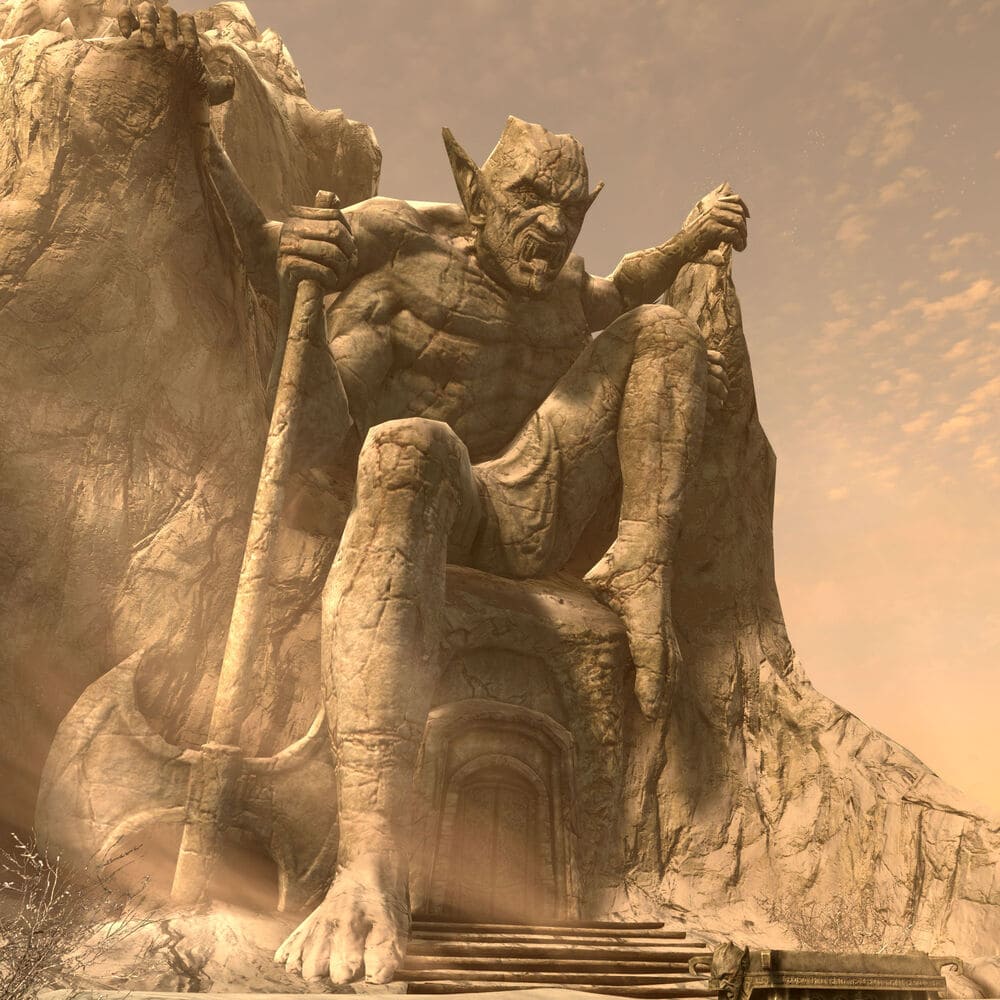 Skyrim Skyrim |
|---|---|---|---|
|
Statuary of Mehrunes Dagon typically depicts him as a hulking four-armed Daedra wielding a large battle-axe. Vast statues of Dagon could be found throughout the Deadlands, his realm of Oblivion.[79] |
During the late-Third Era, numerous statues of Mehrunes Dagon could be found across Vvardenfell, including the Daedric ruins of Ald Sotha, Ebernanit, Ularradallaku, and others. As the Second Corner of the House of Troubles, Mehrunes Dagon was seen as an adversarial god to the Dunmer and represents the trials they face in the lands of Morrowind.[73] Those who sought to become Archcanon of the Temple were required to travel to the statue at Ald Sotha, where Vivec rescued Sotha Sil from the armies of Mehrunes Dagon, and recite Vivec's "Four Corners of the House of Troubles".[80] |
During the late-Third Era, the Mythic Dawn cult established a hidden shrine to Mehrunes Dagon in the caverns near Lake Arrius in Cyrodiil, wherein they built a large statue of the Daedra lord. The statue overlooked a sacrificial altar, where Mankar Camoran himself delivered sermons and initiates of the cult were required to kill captives in order to join the cult. The statue was destroyed when the Hero of Kvatch infiltrated the shrine and stole the Mysterium Xarxes in an effort to stop the Oblivion Crisis.[81] |
An enormous statue of Mehrunes Dagon could be found in the mountains of The Pale in Skyrim during the early-Fourth Era. His monstrous form appears seated atop a small shrine while holding his battle-axe, as he overlooks an altar below. Although its unclear who built the statue, it was known to be associated with the Mythic Dawn, a Daedric cult that rose to prominence during the Oblivion Crisis. The shrine was previously an ancient Nordic tomb before the cult repurposed it in reverence to Dagon.[82] Following the Oblivion Crisis, numerous militia groups formed and pledged to eradicate the remnants of the Mythic Dawn from Tamriel. One such militia group, later known as the Keepers of the Razor, operated in Skyrim and contributed to eradicating the cult's remnants in Nordic lands.[83] |
Mephala[edit] |
|||
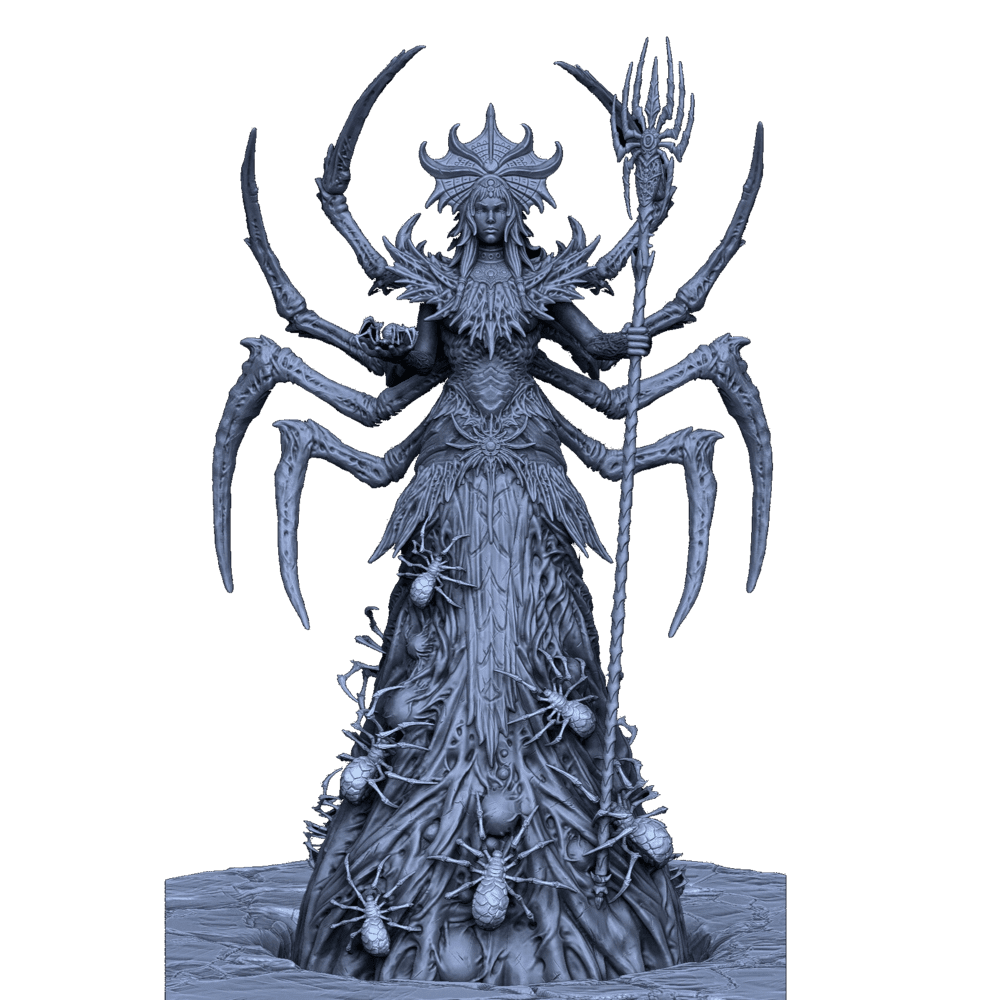 ESO ESO |
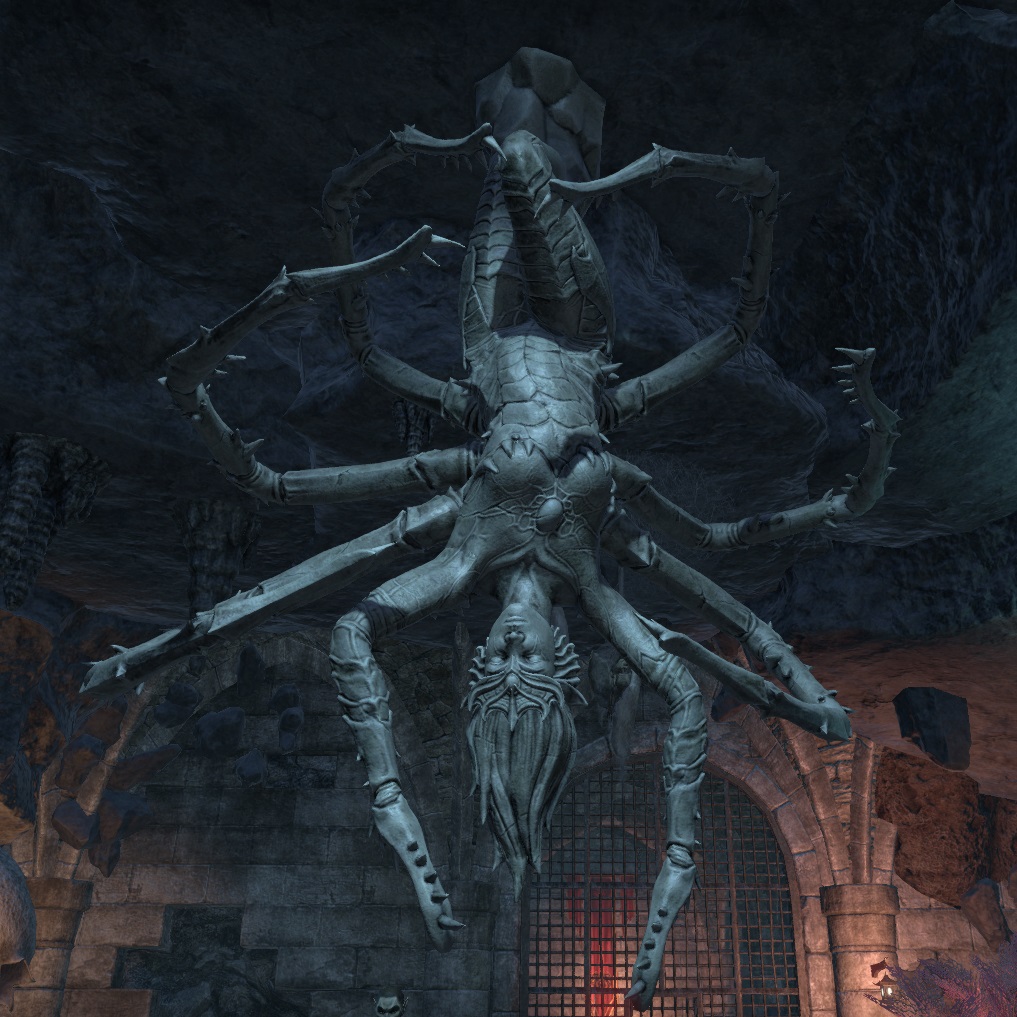 ESO ESO |
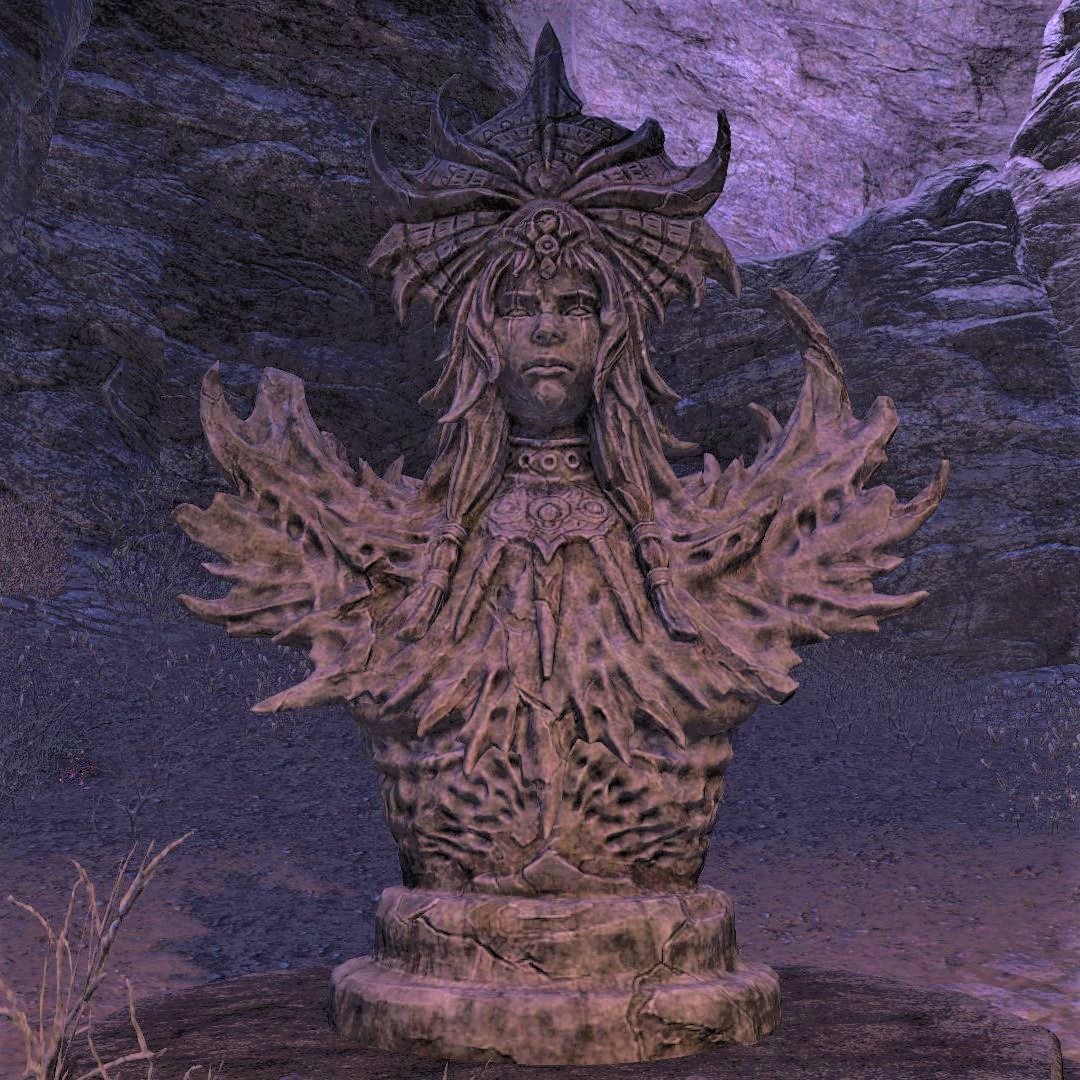 ESO ESO |
|
|---|---|---|---|
|
During the mid-Second Era, Mephala was oft associated with spiders and spider-like iconography. As such, her statuary and idols reflected this as she was typically depicted with numerous spider-like legs protruding from her body.[84] Some of these idols and effigies were adorned with meticulously woven spider silk garments and used in the secret worship of the Daedric Prince.[85][86] One notable example was found in the Cradle of Shadows, where an upside-down statue of Mephala could be found hanging from the ceiling in the Spinner's Sanctuary. [87] Mephala was also featured in Dunmeri basalt sculptures (alongside Azura and Boethiah) and used in their veneration of the "Good Daedra".[88] |
Large sculptures of Mephala, known as Velidreth's Devotion, were found scattered throughout the Cradle of Shadows in Shadowfen. These are large busts had the ability to empower members of the resident Silken Ring cultists and also attack intruders.[89] An identical bust was also found in the Crypt of Hearts in Rivenspire, a former school where Mephala's whisperings corrupted Nerien'eth's mind, until eventually he snapped and ensnared the souls of his students and fellow researchers.[90] |
A statue of Mephala could be found in the wilds of Cyrodiil during the late-Third Era. Although Daedra worship was not prohibited by law in Cyrodiil, public opinion was strongly against it to the extent that Daedra worshippers were forced to practice in secret or in secluded places.[10] Located in the Great Forest, the statue depicts Mephala much less spider-like as in previous statuary, but as a four-armed woman wearing a garland of skulls (although she was still referred to as "the Webspinner").[91][92] The statue also served as a shrine for a small coven and allowed individuals to solicit the Daedra lord directly, provided they possessed sufficient prowess or strength of character, and provided a proper offering.[10][93] |
|
Meridia[edit] |
|||
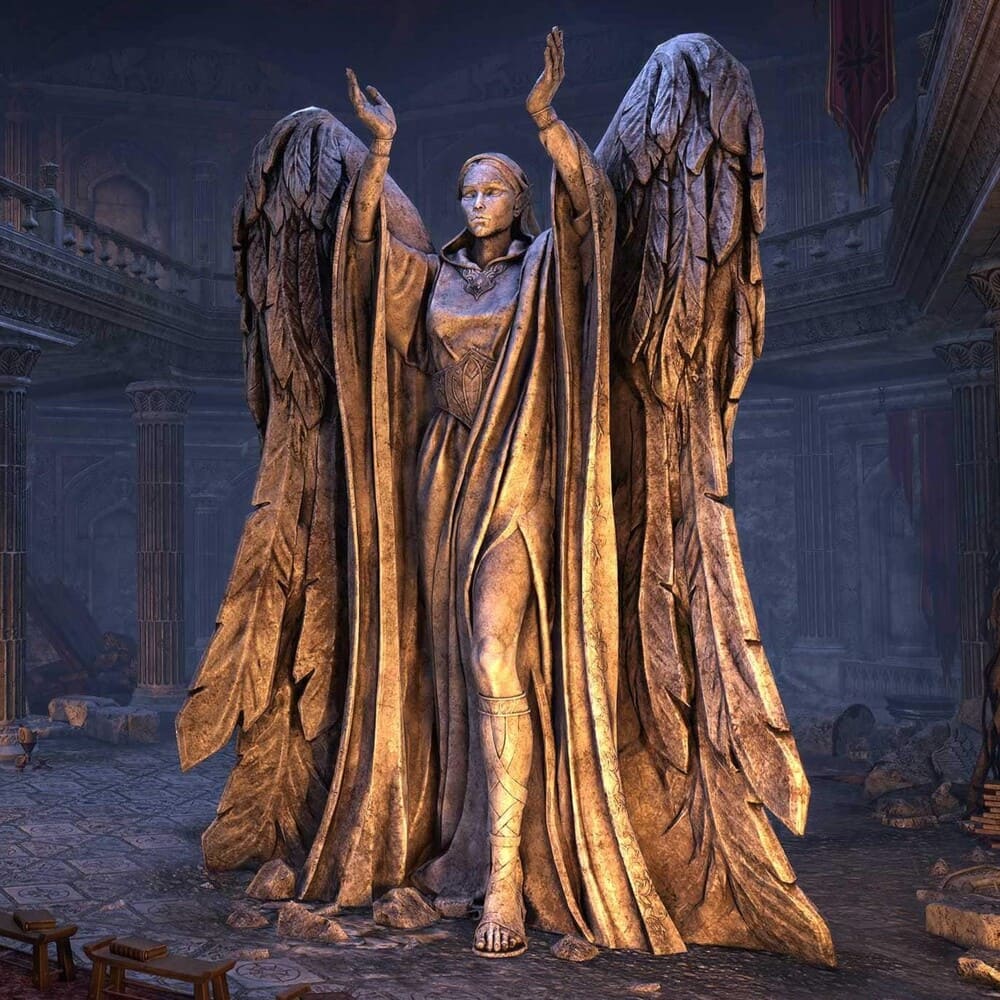 ESO ESO |
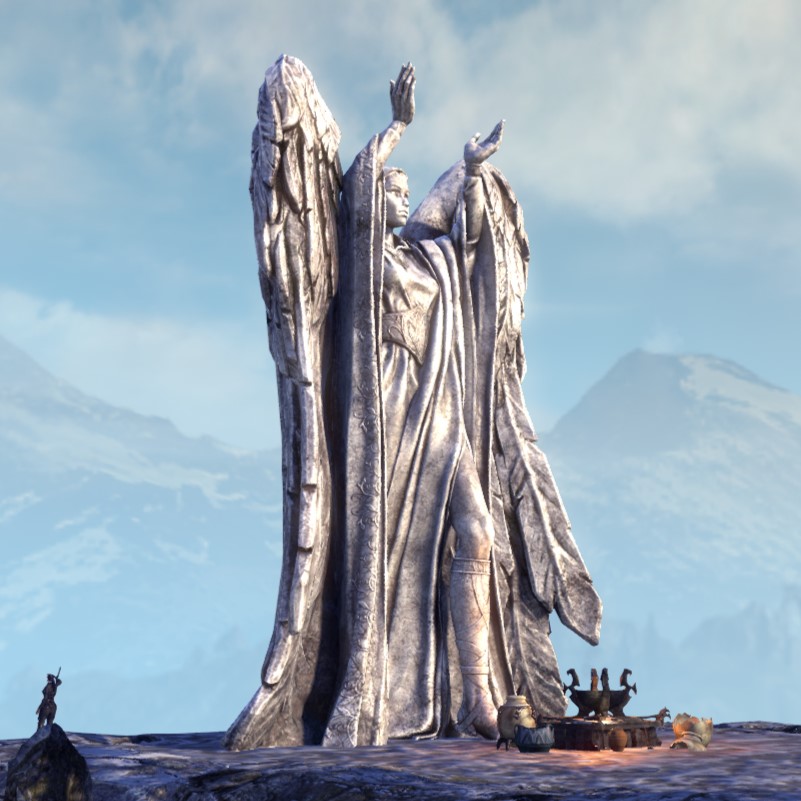 ESO ESO |
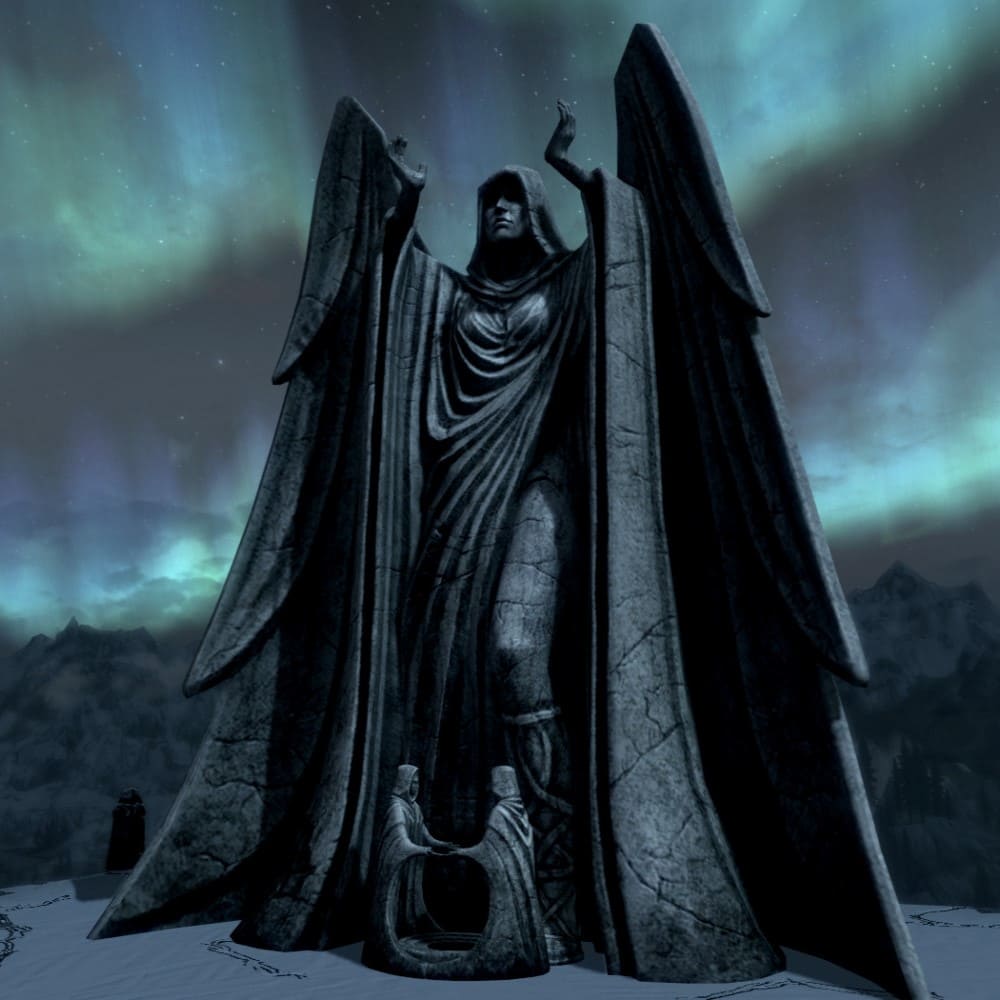 Skyrim Skyrim |
|
|---|---|---|---|
|
Altmeri statuary of Meridia sometimes depicts her as a robed woman with large wings protruding from her torso. Through these statues, she was known to occasionally communicate to mortals or give them instructions. One such example could be seen in a large gleaming statue of her found in a temple deep beneath Eton Nir on Summerset Isle. Home to the Cult of Meridia, the temple was attacked during the mid-Second Era by opposing Daedric forces, and her statue was desecrated.[94][95] |
An identical statue of Meridia was erected outside Kilkreath Temple in Skyrim at some point before the mid-Second Era. Although the Nords largely worshipped the Divines during this time, and Daedra worship was a controversial subject in Tamriel, this particular Daedric temple stood unopposed. Rather, pilgrims and travelers from across Skyrim were known visit the temple to seek refuge, pray, seek blessings or even simply view its architecture. [96][97][98] During the Three Banners War, the priesthood of Meridia's cult tended to the temple and it was led by a high priest.[99] The priests were known to be warm and hospitable with travelers, and welcomed thoughtful, albeit heretical, conversation.[98] At an unknown point after the war, the cult seemingly abandoned the temple and it fell into ruins. Although the statue remained intact at late as the early-Fourth Era, the temple itself was overrun with corrupted shades led by a powerful necromancer.[100] |
A statue of Meridia could be found in the wilds of Cyrodiil during the late-Third Era. Although Daedra worship was not prohibited by law in Cyrodiil, public opinion was strongly against it to the extent that Daedra worshippers were forced to practice in secret or in secluded places.[10] Located in the West Weald, the statue depicts Meridia differently from previous statuary, notably the exclusion of flowing robes and wings.[101] The statue also served as a shrine for a small coven and allowed individuals to solicit the Daedra lord directly, provided they possessed sufficient prowess or strength of character, and provided a proper offering.[10][102] |
|
Molag Bal[edit] |
|||||
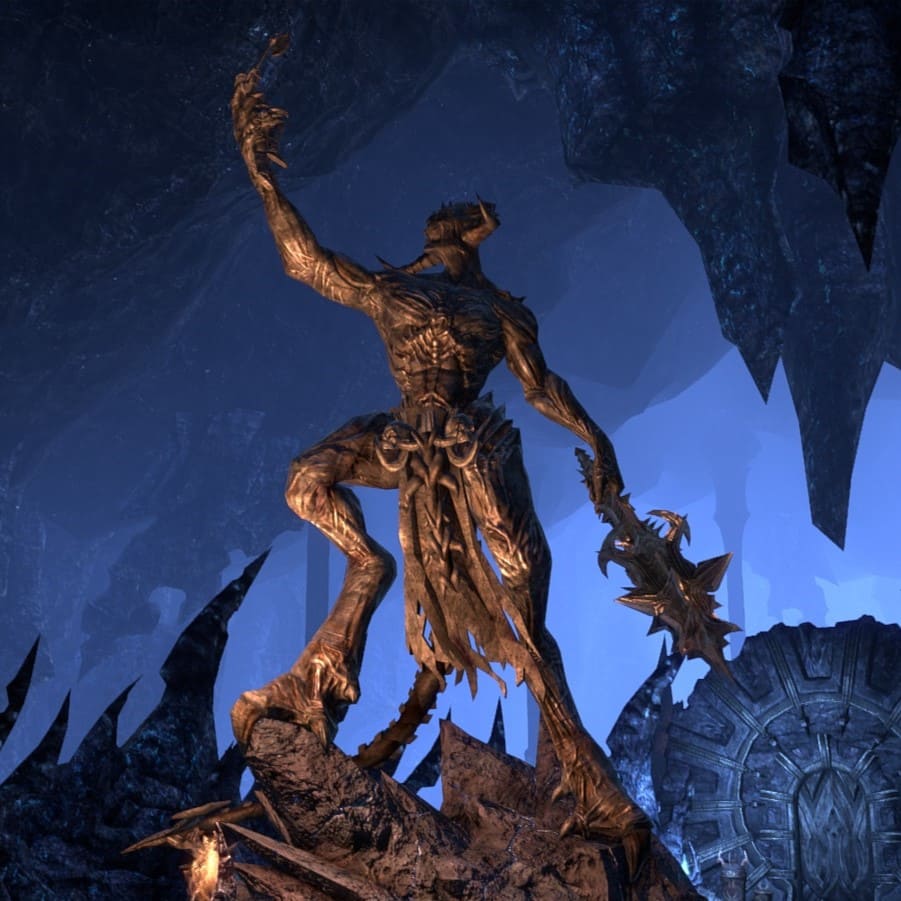 ESO ESO |
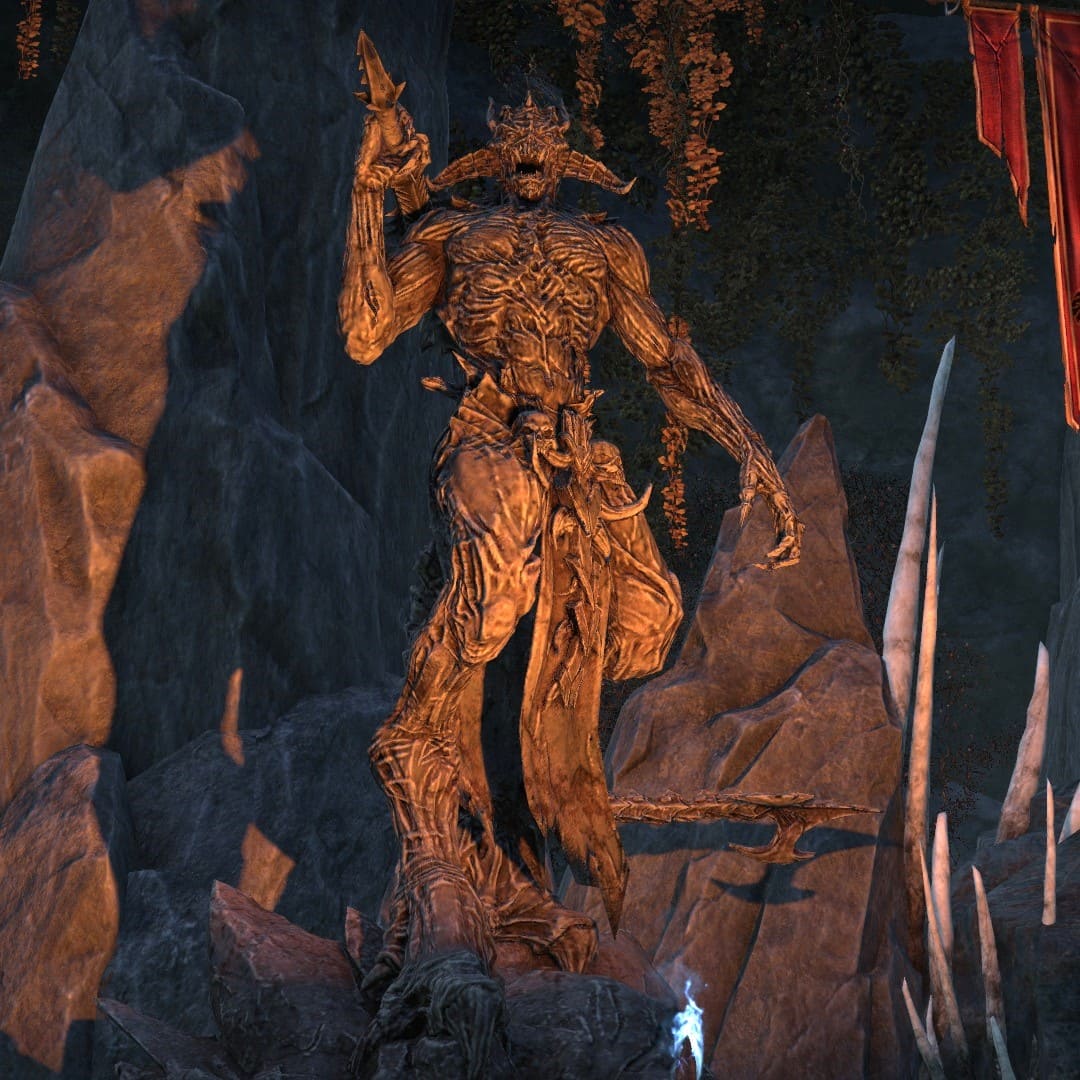 ESO ESO |
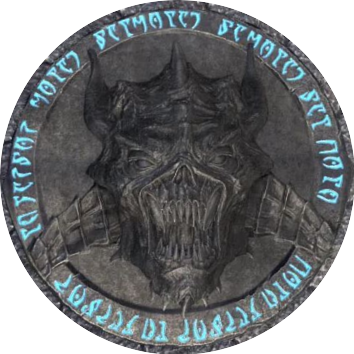 ESO ESO |
|||
|---|---|---|---|---|---|
|
Statuary of Molag Bal during the Planemeld typically depicted him as a hulking horned Daedra wielding his infamous mace. Vast statues of Molag Bal could be found throughout Coldharbour, his realm of Oblivion.[103] Similar statues could be found on Tamriel, usually in Worm Cult strongholds, such the ruined Daedric temples of Ashalmawia or Bal Ur in Vvardenfell.[104][105] Other examples of sculpture include intricately carved effigies made of solid obsidian with ruby eyes that were used by Stonefire Cultists in their dark ceremonies. [106] Bas-reliefs bearing his terrifying visage could also be found in various places associated with him, such as the mooring of the Great Shackle.[107][108] |
|||||
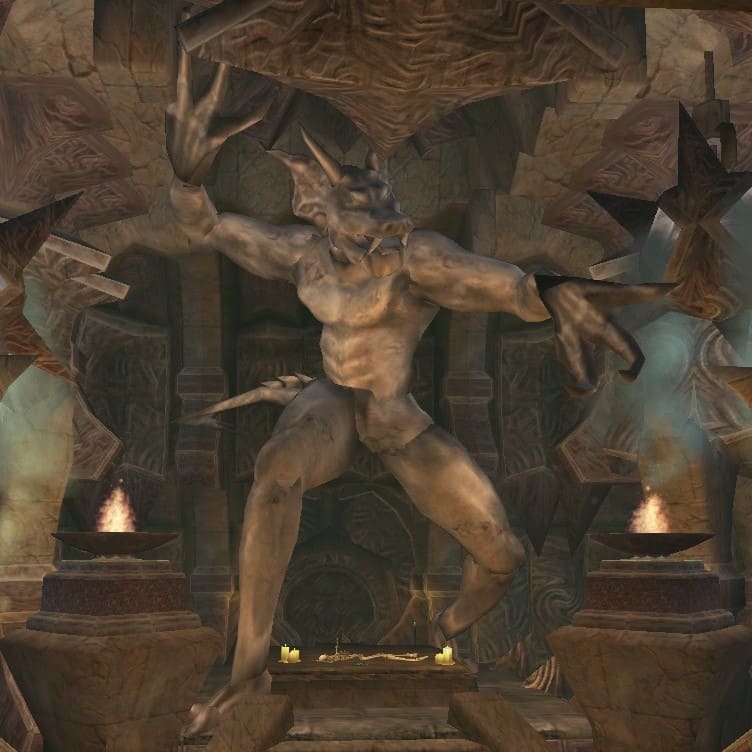 Morrowind Morrowind |
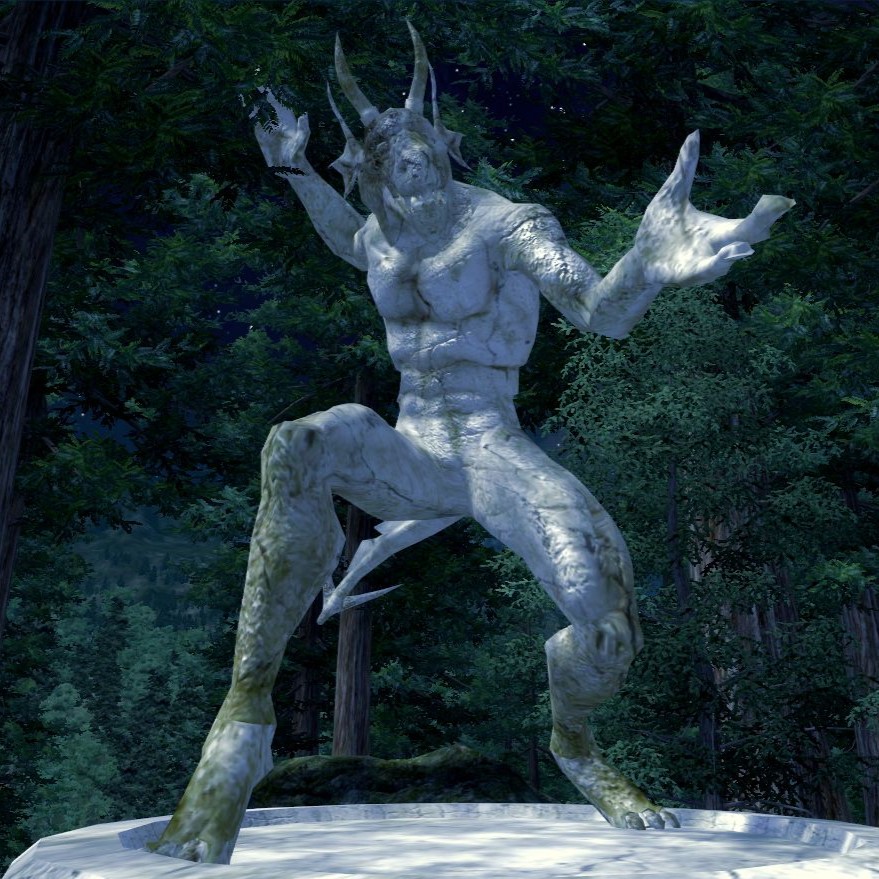 Oblivion Oblivion |
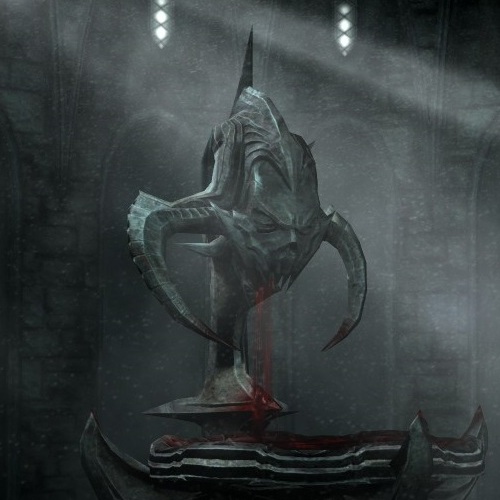 Skyrim Skyrim |
|||
|
During the late-Third Era, numerous statues of Molag Bal could be found across Vvardenfell, including the Daedric ruins of Ramimilk, Kushtashpi, Tusenend, and others. As the Third Corner of the House of Troubles, Molag Bal was seen as an adversarial god to the Dunmer who tries to destroy them by corrupting their bloodlines.[73] Those who sought to become Archcanon of the Temple were required to travel to the statue at Bal Ur and recite Vivec's "Four Corners of the House of Troubles". Bal Ur itself was believed to be the birthplace of Molag Bal and where Vivec defeated him and sent him back into Oblivion.[109][73] |
A statue of Molag Bal could be found in the wilds of Cyrodiil during the late-Third Era. Although Daedra worship was not prohibited by law in Cyrodiil, public opinion was strongly against it to the extent that Daedra worshippers were forced to practice in secret or in secluded places.[10] Located in the Great Forest, the statue depicts Molag Bal in a similar manner as statues found in Vvardenfell, and also served as a shrine for a small coven.[110] This shrine also allowed individuals to solicit the Daedra lord directly, provided they possessed sufficient prowess or strength of character, and provided a proper offering.[10][111] |
A stylized bust of Molag Bal could be found in Castle Volkihar during the early-Fourth Era. Located in the castle's cathedral, it served as an unholy shrine to the Daedra lord and depicted a large horned head with blood pouring from its mouth into a large basin. The castle was home to Lord Harkon of the Volkihar clan, who pledged himself to Molag Bal and made a pact with him. As a reward, Molag Bal gifted him with everlasting life by way of vampirism.[112][113] |
|||
Namira[edit] |
||||
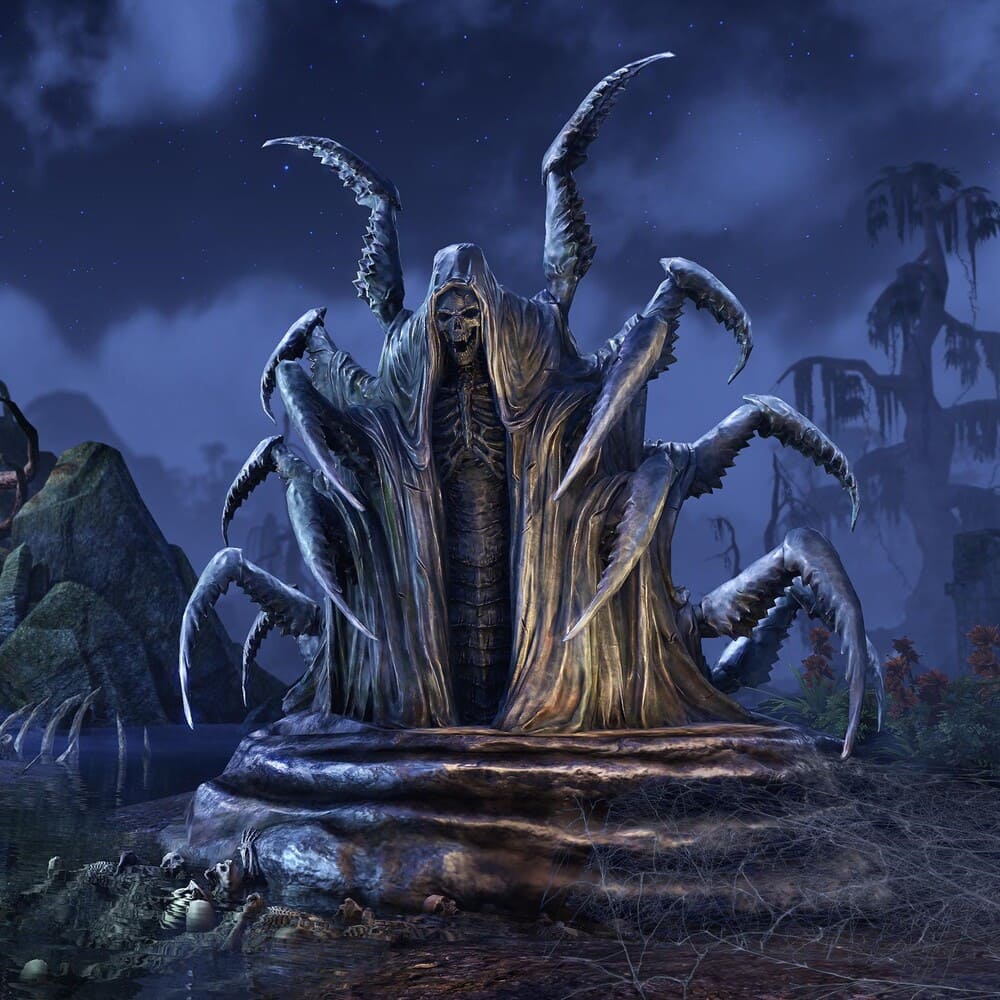 ESO ESO |
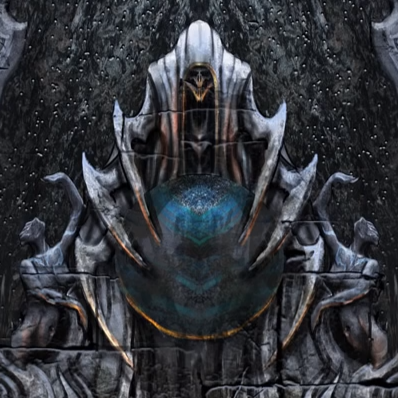 ESO ESO |
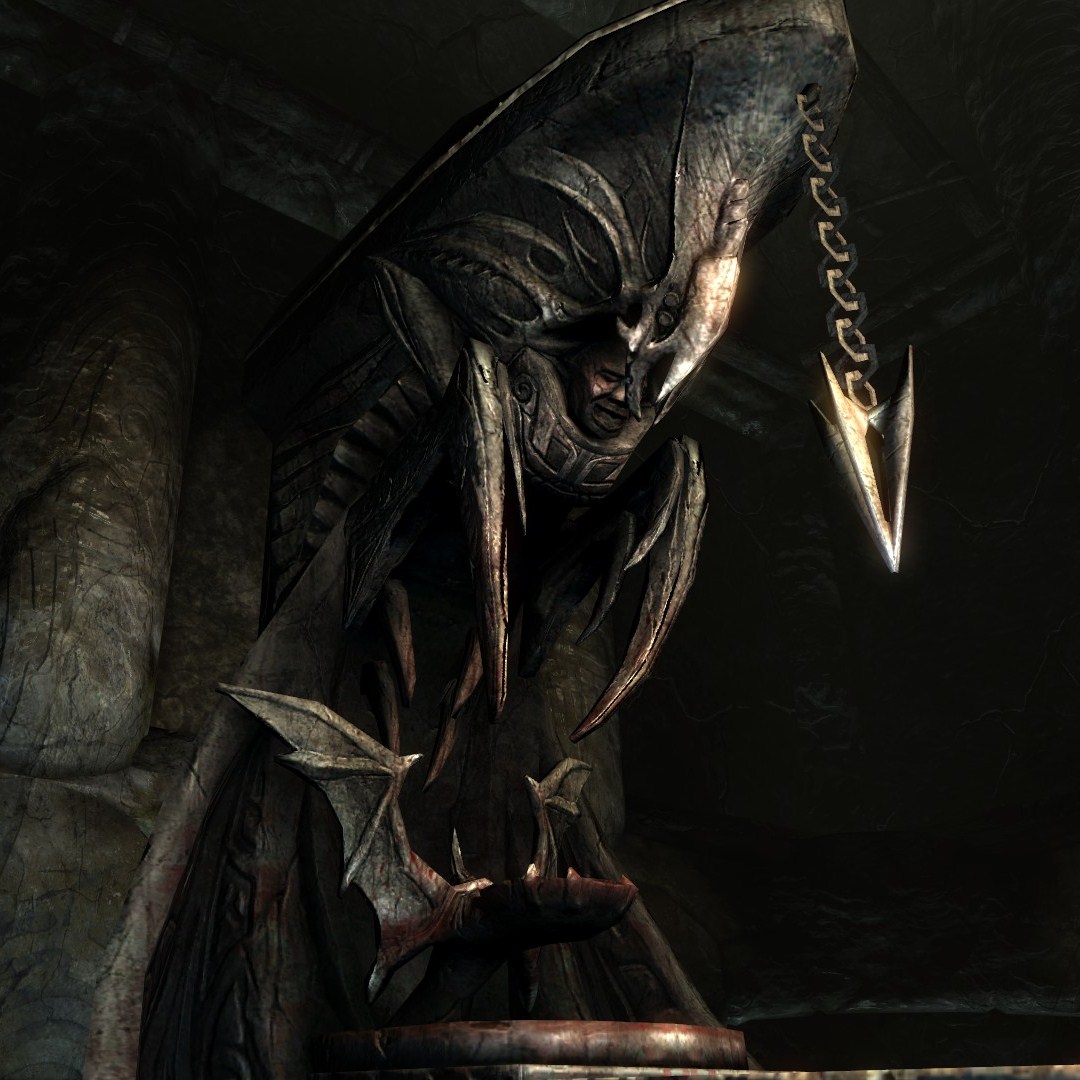 Skyrim Skyrim |
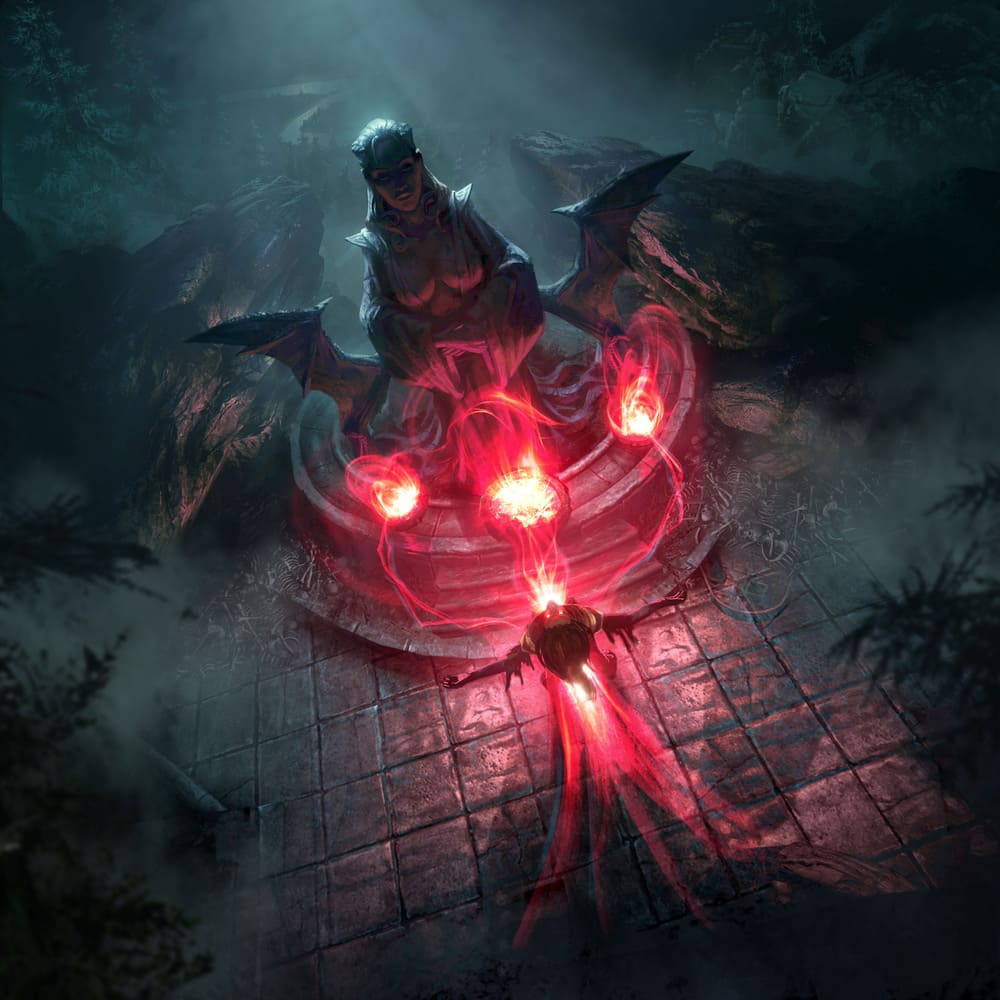 Legends Legends |
|
|---|---|---|---|---|
|
Statuary or bas-reliefs of Namira are uncommon, but those that are known to exist typically depict her as a woman in some form. Given Namira is often associated with slugs, spiders, and other things that inspire instinctive revulsion in mortals, her statuary sometimes reflects this. For example, statues and bas-reliefs from the mid-Second Era (such as the one found in the Temple of Seven Riddles) depicts Namira in a horrifying skeletal from, with crab-like legs protruding from her torso. [114][115] A statue of Namira could be found in the wilds of Cyrodiil during the late-Third Era. Although Daedra worship was not prohibited by law in Cyrodiil, public opinion was strongly against it to the extent that Daedra worshippers were forced to practice in secret or in secluded places.[10] Located in the Jerall Mountains, the statue depicts Namira in a much less grotesque from as seen in previous statuary, but as a robed woman with a small daedra by her feet.[116] The statue also served as a shrine for a small coven and allowed individuals to solicit the Daedra lord directly, provided they possessed sufficient prowess or strength of character, and provided a proper offering.[10][117] Other statuary or shrines dedicated to Namira from the early-Fourth Era sometimes depicts her alongside bat-like imagery and motifs.[118][119] |
||||
Nocturnal[edit] |
||
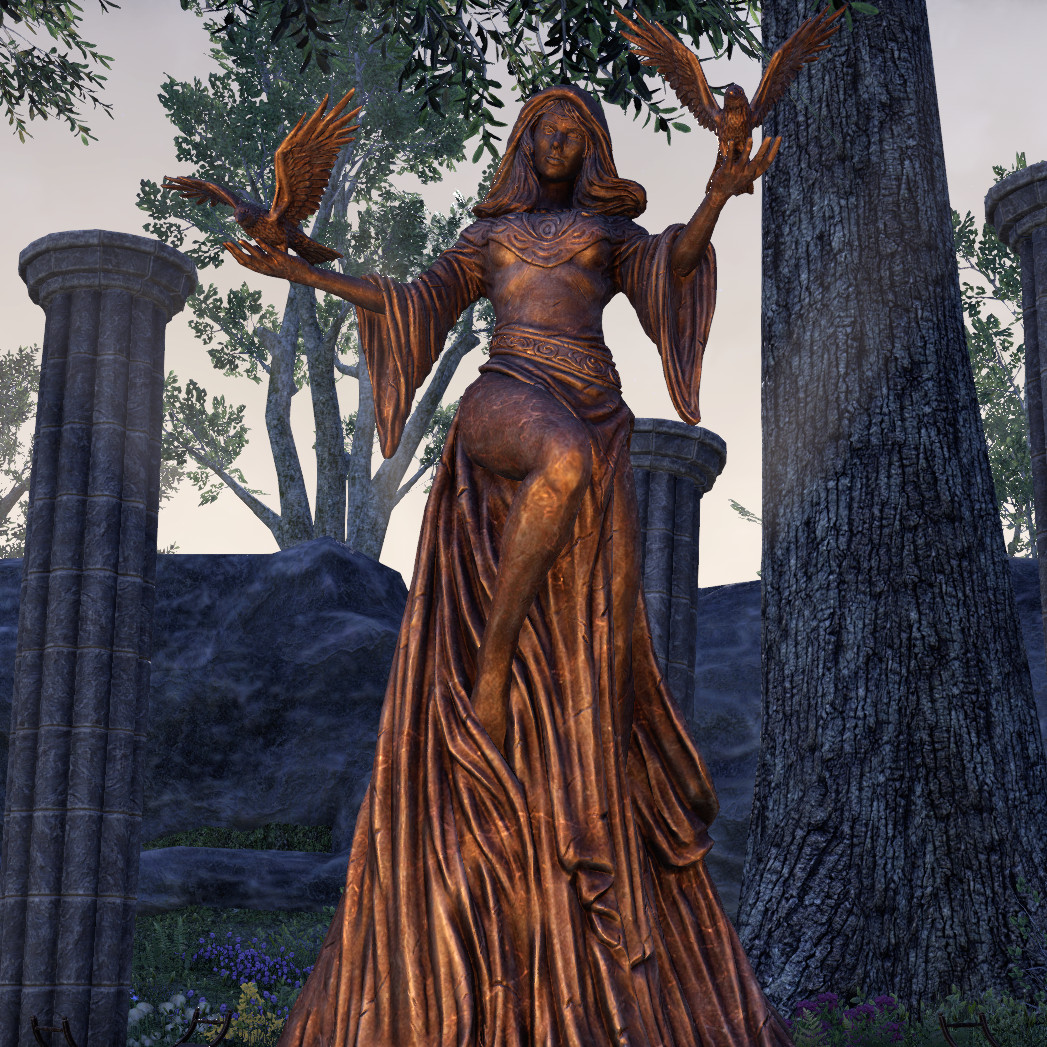 ESO ESO |
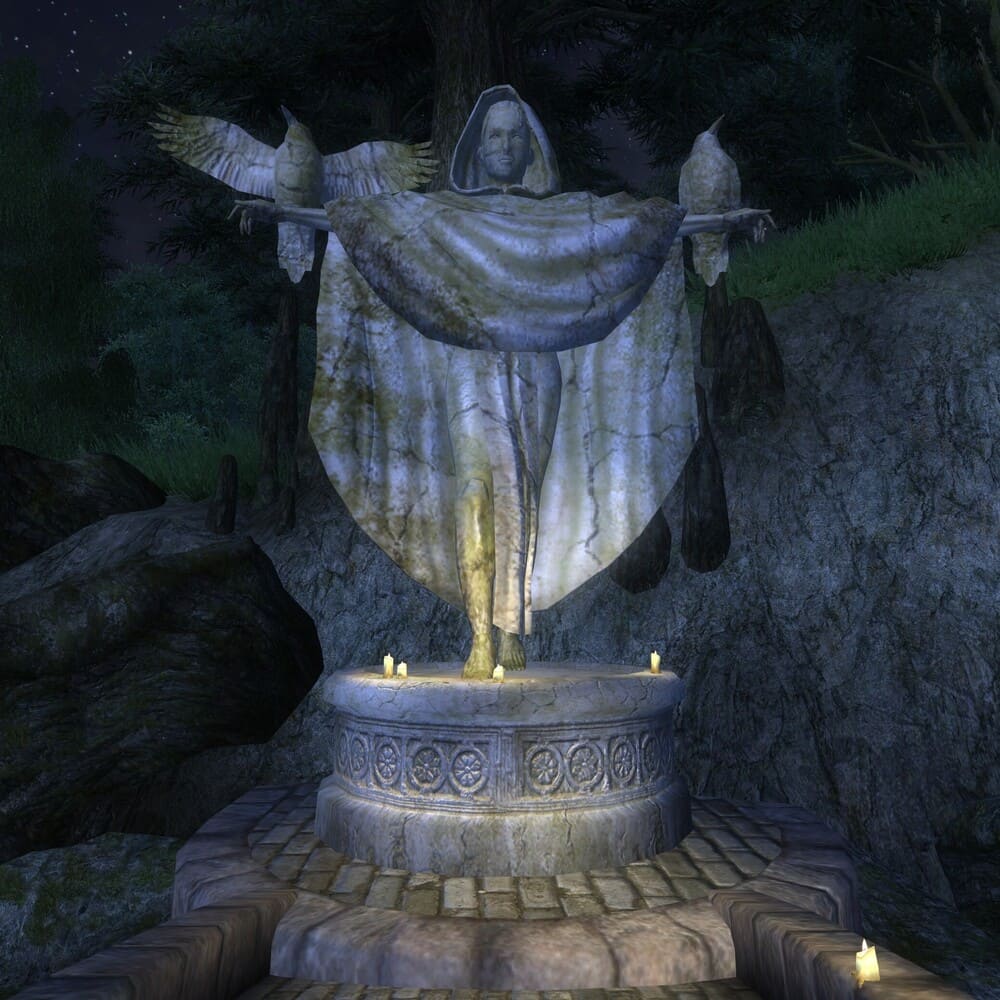 Oblivion Oblivion |
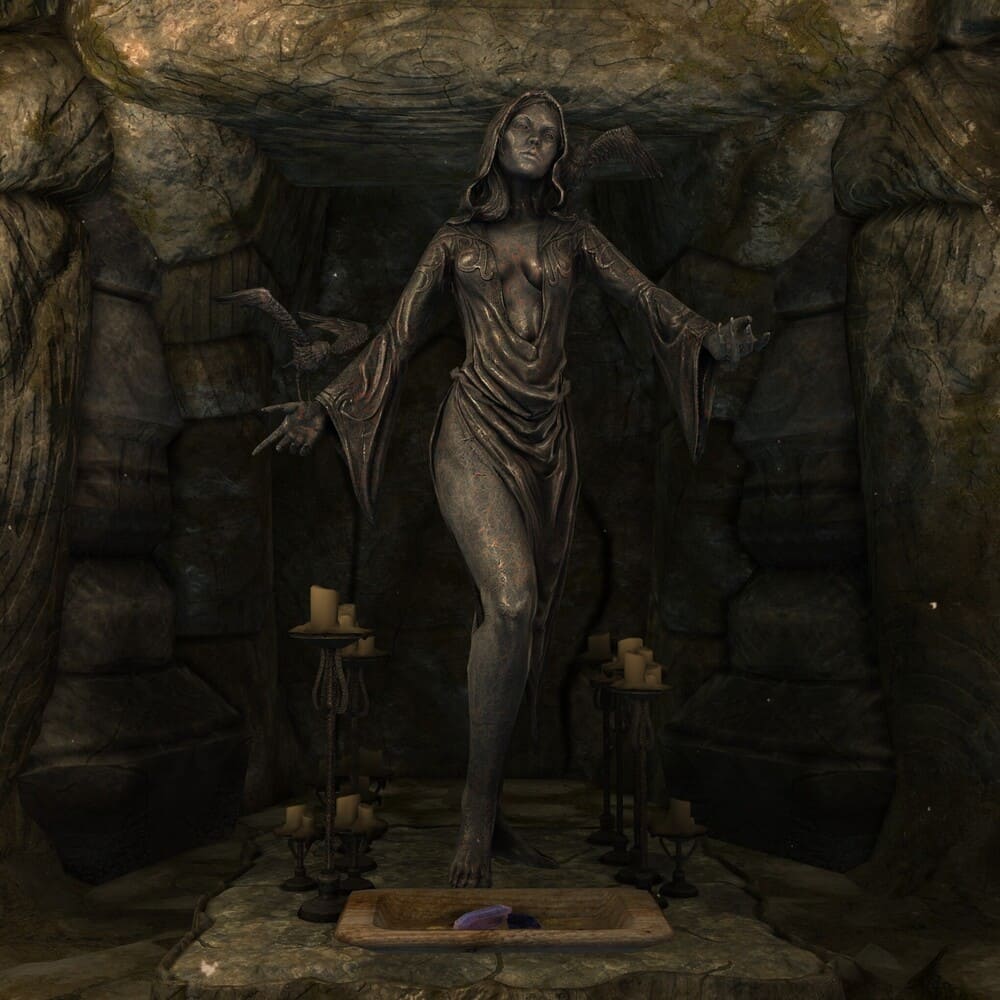 Skyrim Skyrim |
|---|---|---|
|
Statuary of Nocturnal typically depicts her as a robed woman with crows perched upon her arms. Through these statues, she was known to occasionally communicate to mortals or give them instructions. One such example could be seen in the Blackwood region of Cyrodiil, where a statue of her was erected dating back to at least the mid-Second Era.[120] The Shade Sickle, a powerful instrument of Nocturnal's will, was kept at the Daedric shrine during the Three Banners War, and was briefly stolen by a necromancer before it was recovered.[121][122] By the late-Third Era, the Shade Sickle was no longer found at the shrine, but a small coven of Nocturnal cultists had taken up residence.[123] They allowed individuals to solicit the Daedra lord directly, provided they possessed sufficient prowess or strength of character, and provided a proper offering.[10][124] |
Two almost identical statues of Nocturnal could be found in Skyrim during the early-Fourth Era. One was discovered in the ancient sanctuary of Twilight Sepulcher during the Nightingales efforts to return the Skeleton Key to its rightful place.[125] Another was erected in the Ragged Flagon beneath Riften after the Thieves Guild was restored to its former glory.[126] |
|
Peryite[edit] |
||
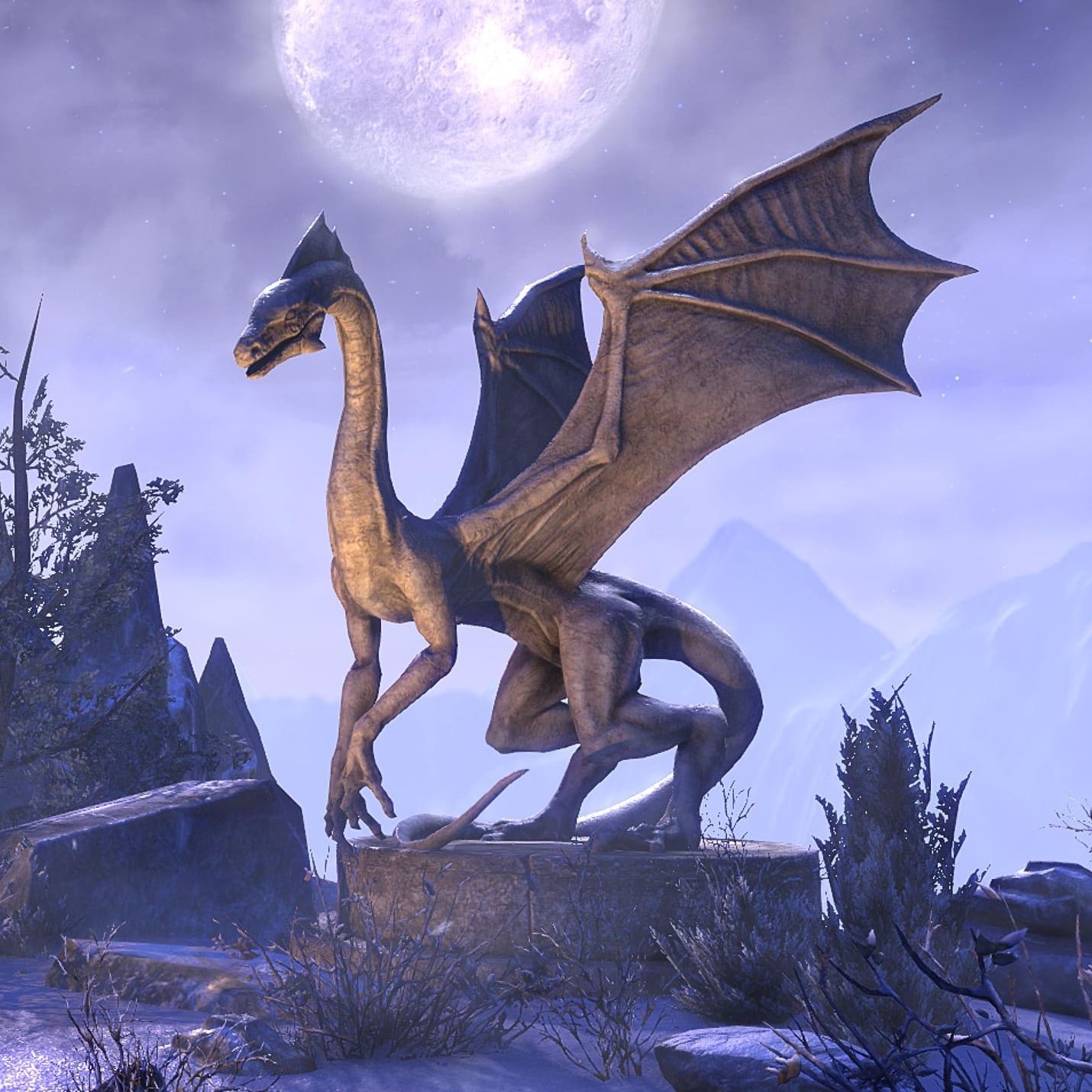 ESO ESO |
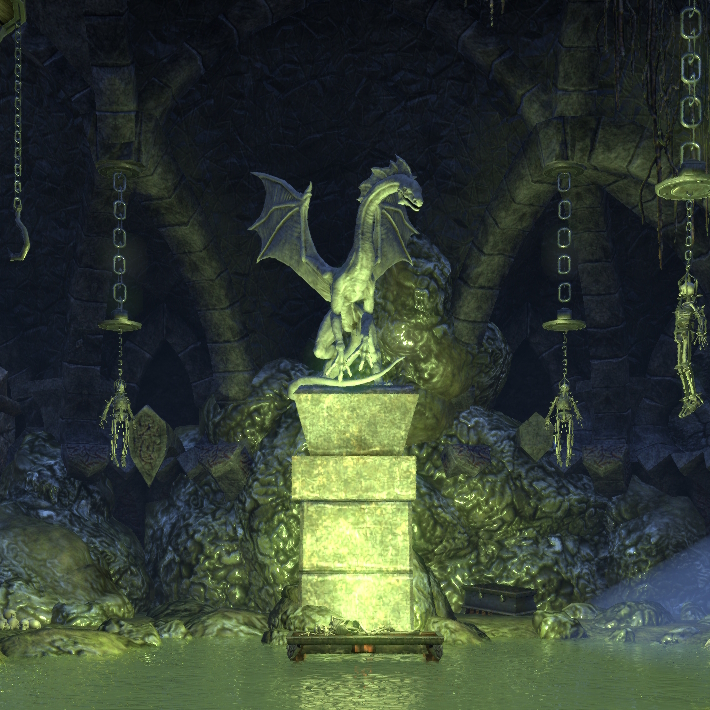 ESO ESO |
|
|---|---|---|
| Peryite typically takes the form of one of his sacred symbols: a four-legged dragon, and his statuary reflects this.[127] One notable example could be found at the summit of Scalecaller Peak, where the Dragon Priest Zaan the Scalecaller found refuge after her master, Thurvokun, abandoned her.[128] It was here Zaan turned to worship Peryite and erected three large statues of the Daedra lord, which also functioned as defensive sentries by way of spitting poisonous fumes at any intruders.[129] | Numerous statues of Peryite could be found in the town of Bal Sunnar in Morrowind as a result of a temporal distortion.[130] In an alternate reality, Bal Sunnar lay in ruins after the town's founder, Matriarch Lladi Telvanni, traveled into the future and made a defensive pact with Peryite.[131] This resulted in the construction of a vast temple dotted with statues dedicated to the Taskmaster.[132][133] |
A statue of Peryite could be found in the wilds of Cyrodiil during the late-Third Era. Although Daedra worship was not prohibited by law in Cyrodiil, public opinion was strongly against it to the extent that Daedra worshippers were forced to practice in secret or in secluded places.[10] Located in the Nibenay Valley, the statue depicts Peryite once again as a dragon and also served as a shrine for a small coven.[134] This shrine also allowed individuals to solicit the Daedra lord directly, provided they possessed sufficient prowess or strength of character, and provided a proper offering.[10][135] |
Sanguine[edit] |
|
|
Statuary of Sanguine is particularly rare, and only one example is known to exist. Found in the Colovian Highlands in Cyrodiil during the late-Third Era, the statue depicts Sanguine as a stocky, horned Dremora-like creature head holding a flagon and standing on a skull.[136] The statue also served as a shrine for a small coven and allowed individuals to solicit the Daedra lord directly, provided they possessed sufficient prowess or strength of character, and provided a proper offering.[10][137] |
|
Sheogorath[edit] |
|||||
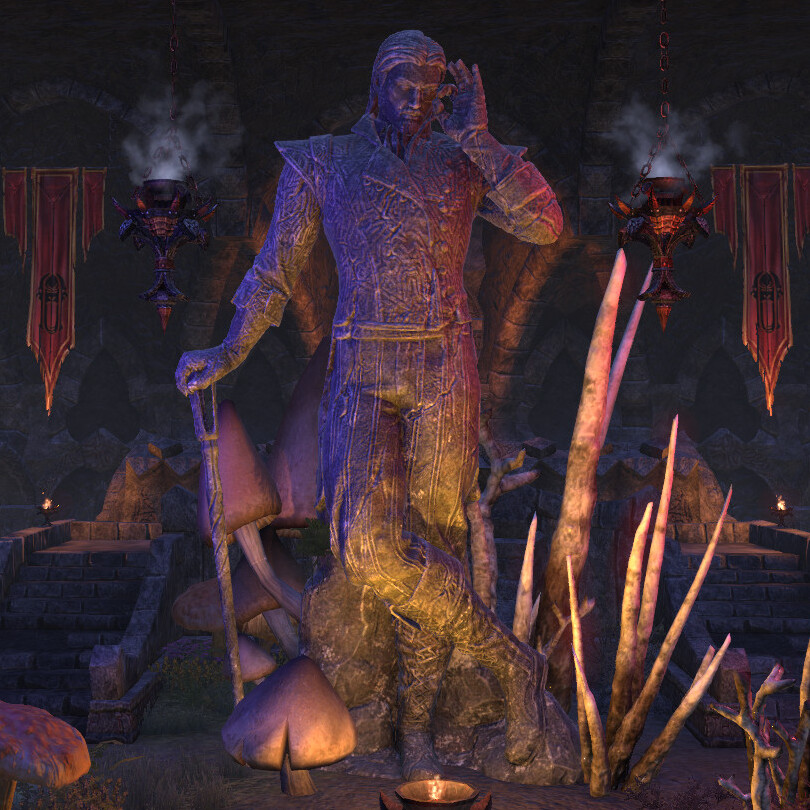 ESO ESO |
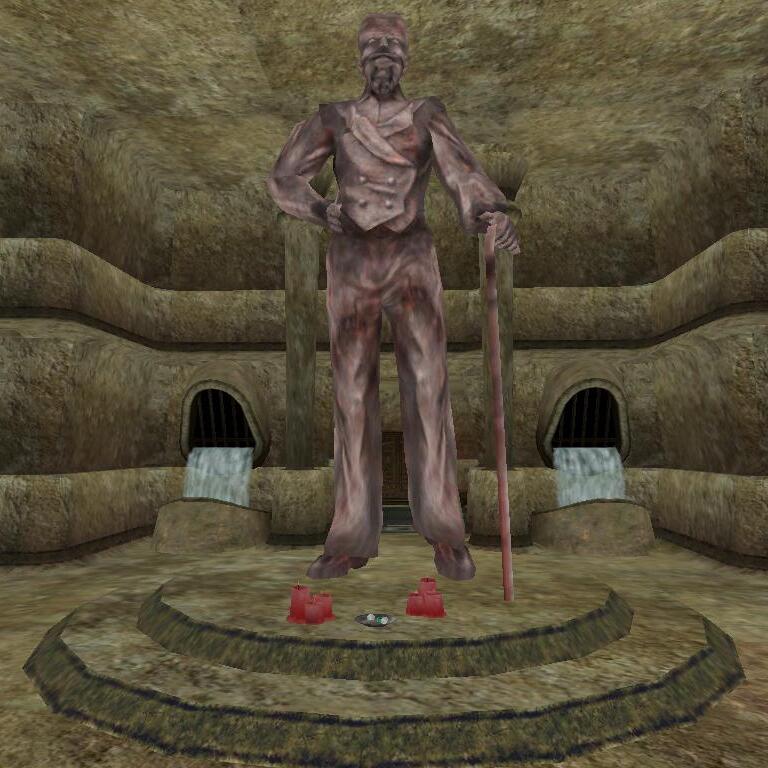 Morrowind Morrowind |
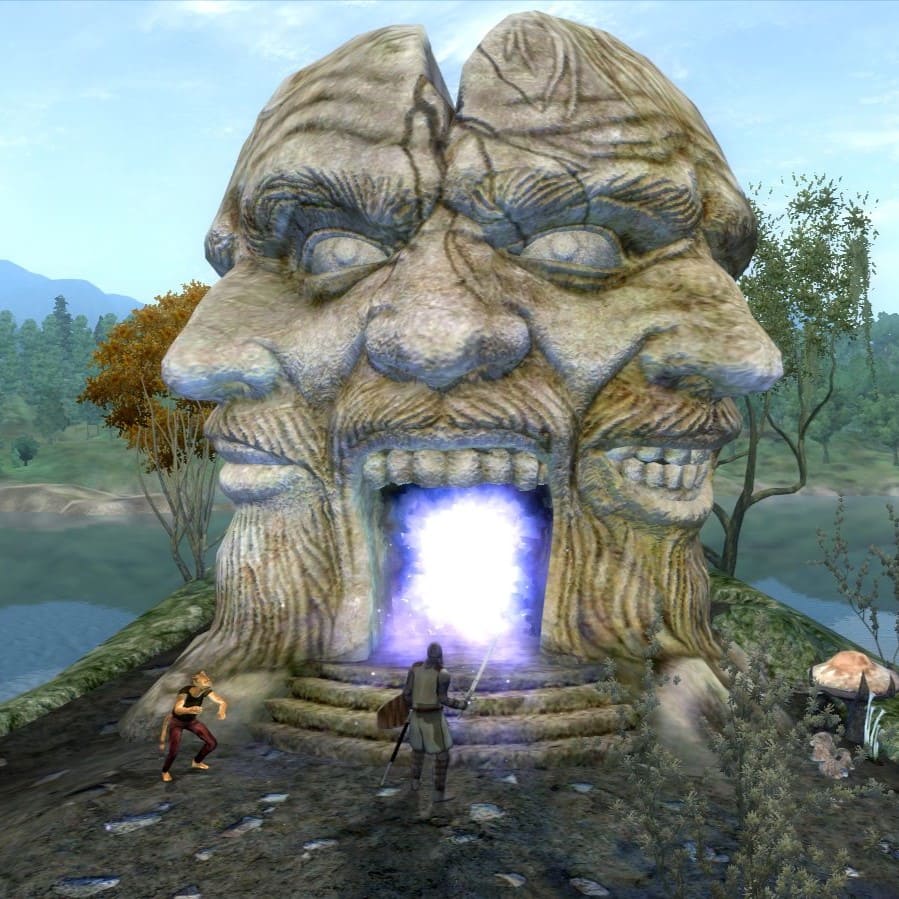 Oblivion Oblivion |
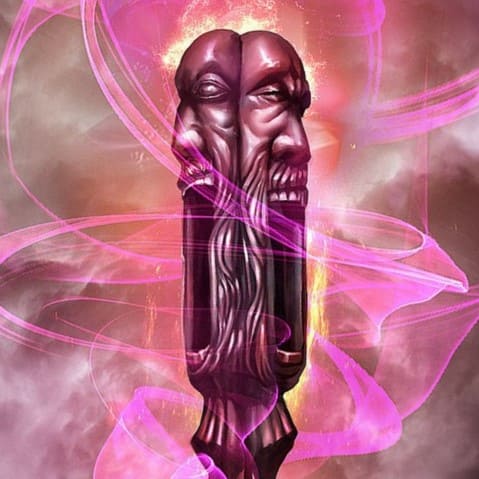 Legends Legends |
||
|---|---|---|---|---|---|
|
Statuary of Shegorath dating back to at least the mid-Second Era depict him as a flamboyantly dressed man holding a walking cane. By the late-Third Era, numerous statues of Sheogorath could be found across Vvardenfell, including the Daedric ruins of Ald Daedroth, Zaintiraris, Maelkashishi and others. As the Fourth Corner of the House of Troubles, Sheogorath was seen as an adversarial god to the Dunmer and was known to test them for mental weakness.[73][138] Those who sought to become Archcanon of the Temple were required to travel to the statue at Ald Daedroth and renew a pact Vivec made with Sheogorath long ago, that prevented Sheogorath from tormenting them with madness. This involved donating an artifact named Gambolpuddy while reciting Vivec's "Four Corners of the House of Troubles".[139][73] Another statue could be found in the Blackwood region of Cyrodiil around the same time.[140] The statue also served as a shrine for a small coven and allowed individuals to solicit the Daedra lord directly, provided they possessed sufficient prowess or strength of character, and provided a proper offering.[10][141] |
During the late-Third Era, a large sculpture mysteriously appeared on a small island in the middle of the Niben Bay. The abstract statue depicted Sheogorath in three different expressions, with the center statue serving as a portal to his realm, the Shivering Isles.[142] Sheogorath's infamous staff, the Wabbajack, also featured a similar design, depicting his various expressions carved into the tip.[143] |
||||
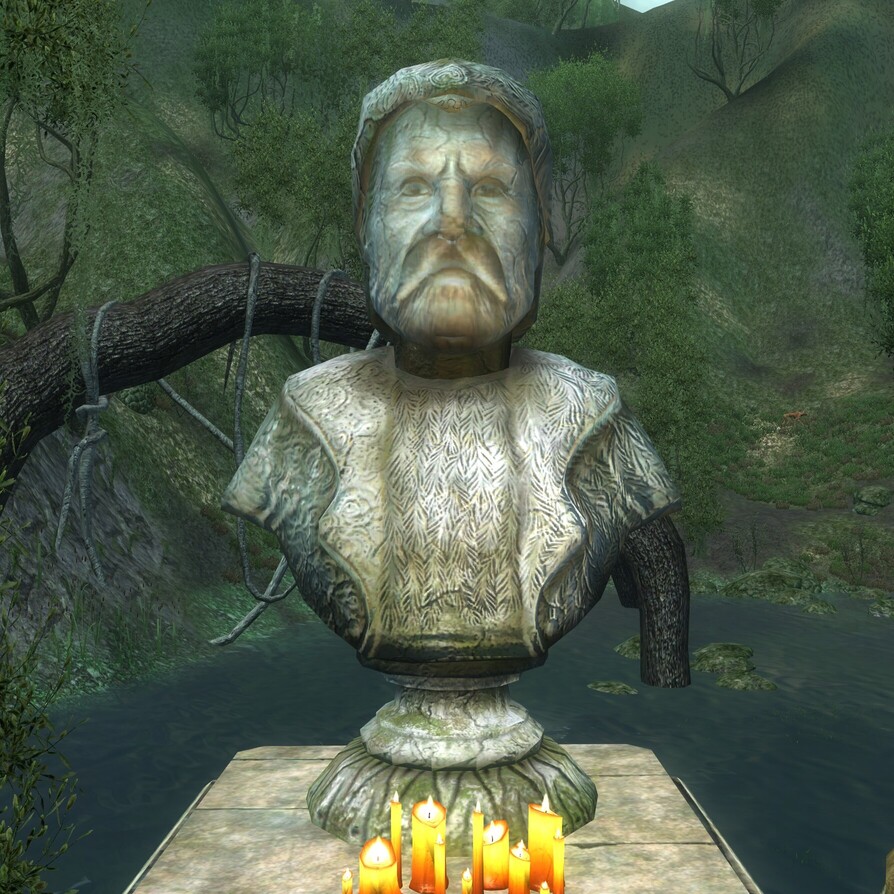 Oblivion Oblivion |
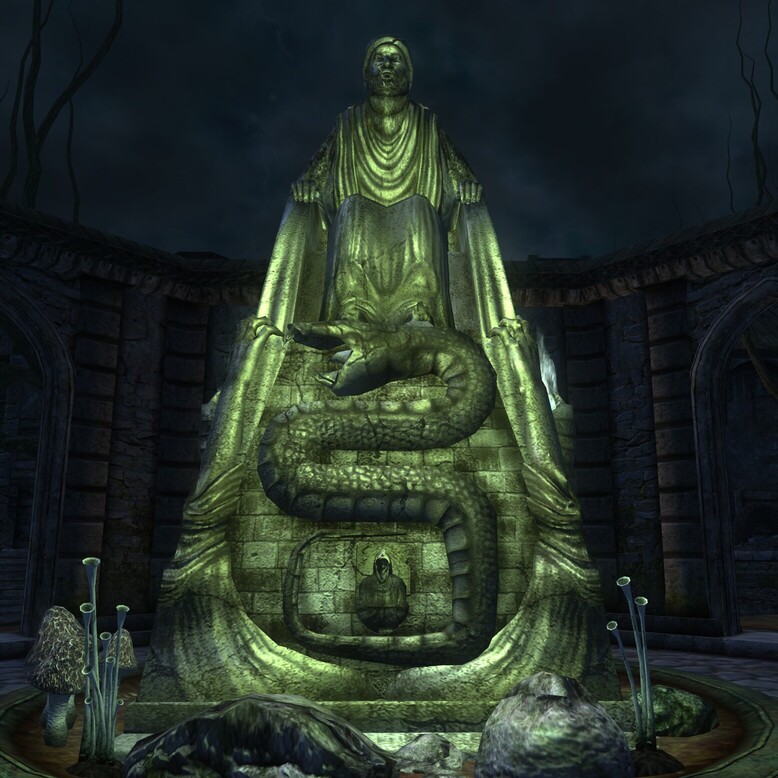 Oblivion Oblivion |
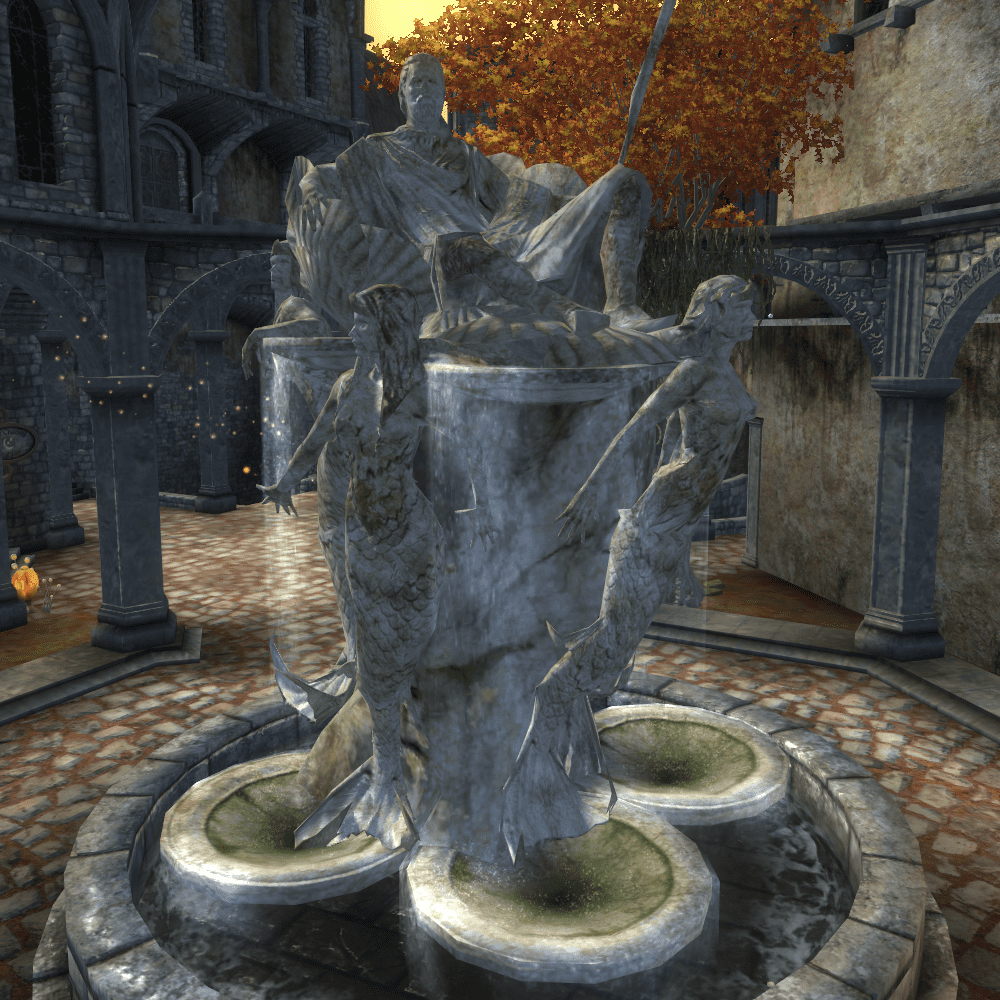 Oblivion Oblivion |
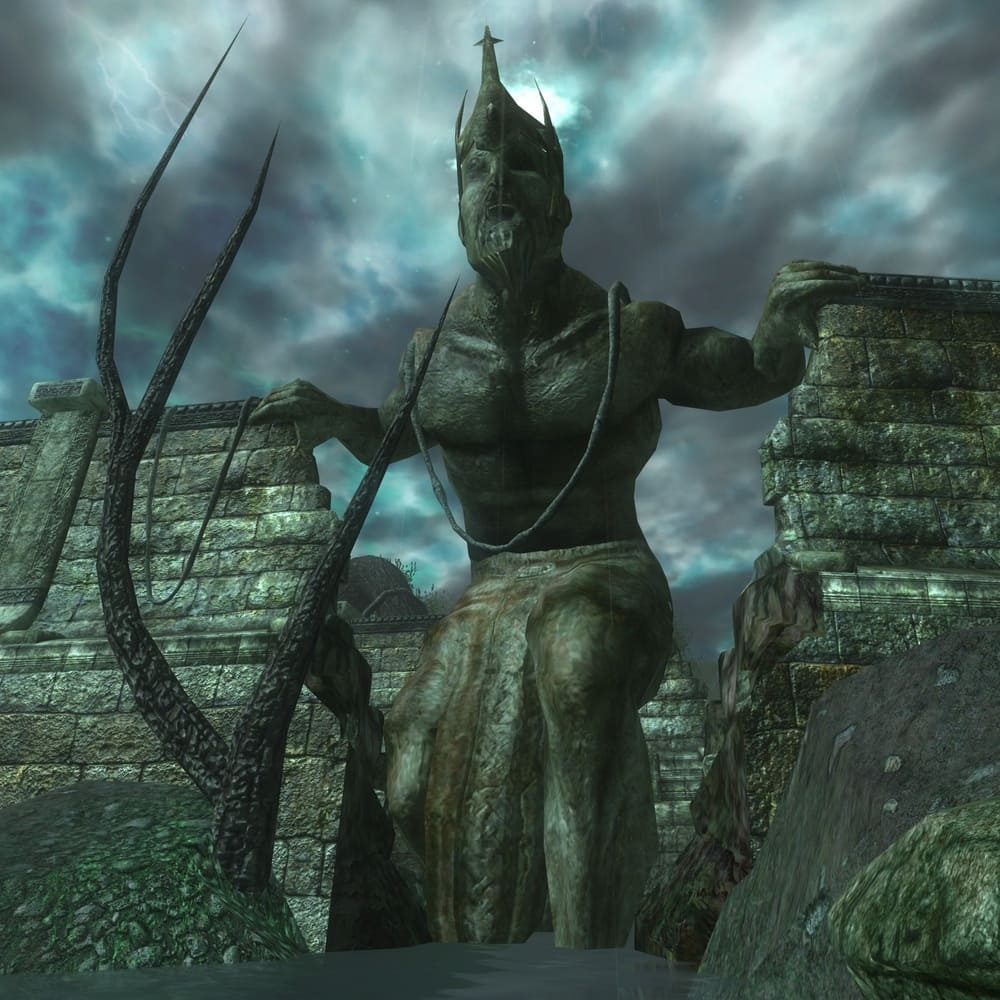 Oblivion Oblivion |
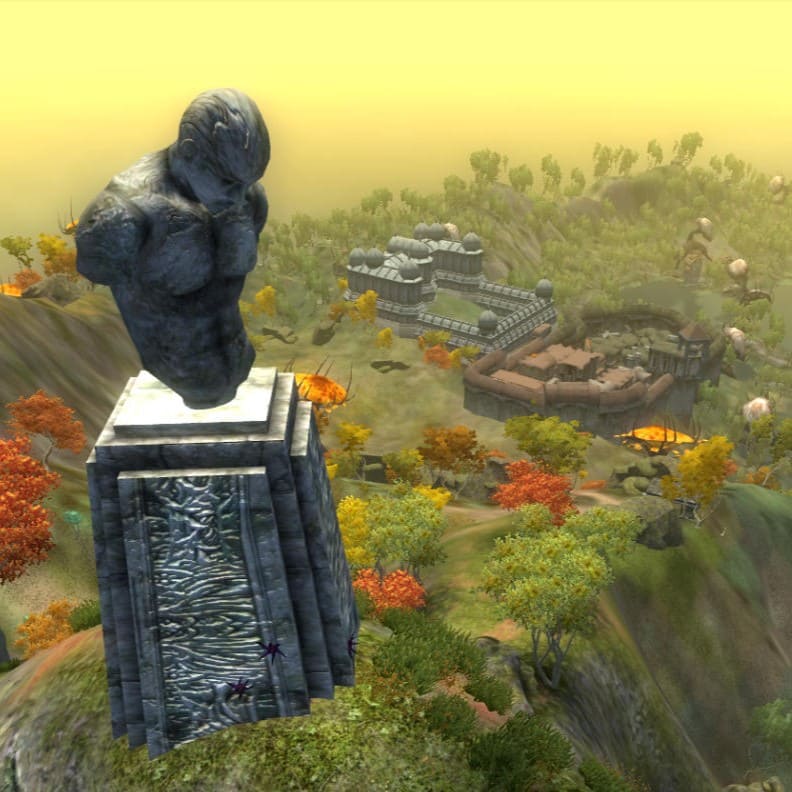 Oblivion Oblivion |
|
|
Numerous statues of Sheogorath could be found within the Shivering Isles itself, depicting him in various styles. These included a simple bust as seen outside the Gates of Madness in The Fringe. Similar busts could be found in Skyrim in the Fourth Era.[144] In Crucible he could be seen seated on a throne with a winding serpent below him. In Bliss he could be seen on a mermaid-themed fountain while lounging on his throne. In other locations in his realm, Sheogorath's statues also served as traps for unwary adventurers. Arguably most notable statue of Sheogorath is the vast sculpture of him that sits at the highest point of the isles overlooking New Sheoth.[145] |
|||||
Vaermina[edit] |
||||
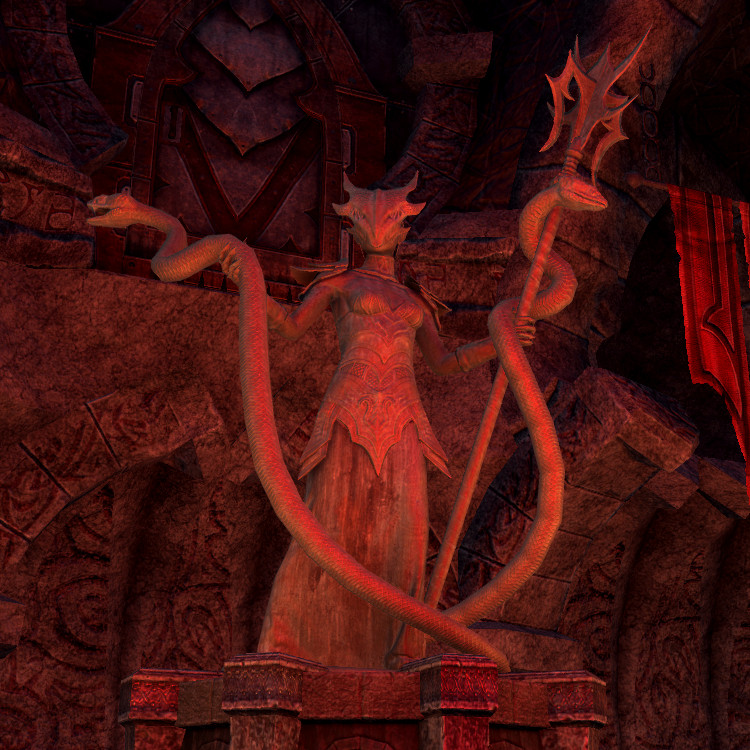 ESO ESO |
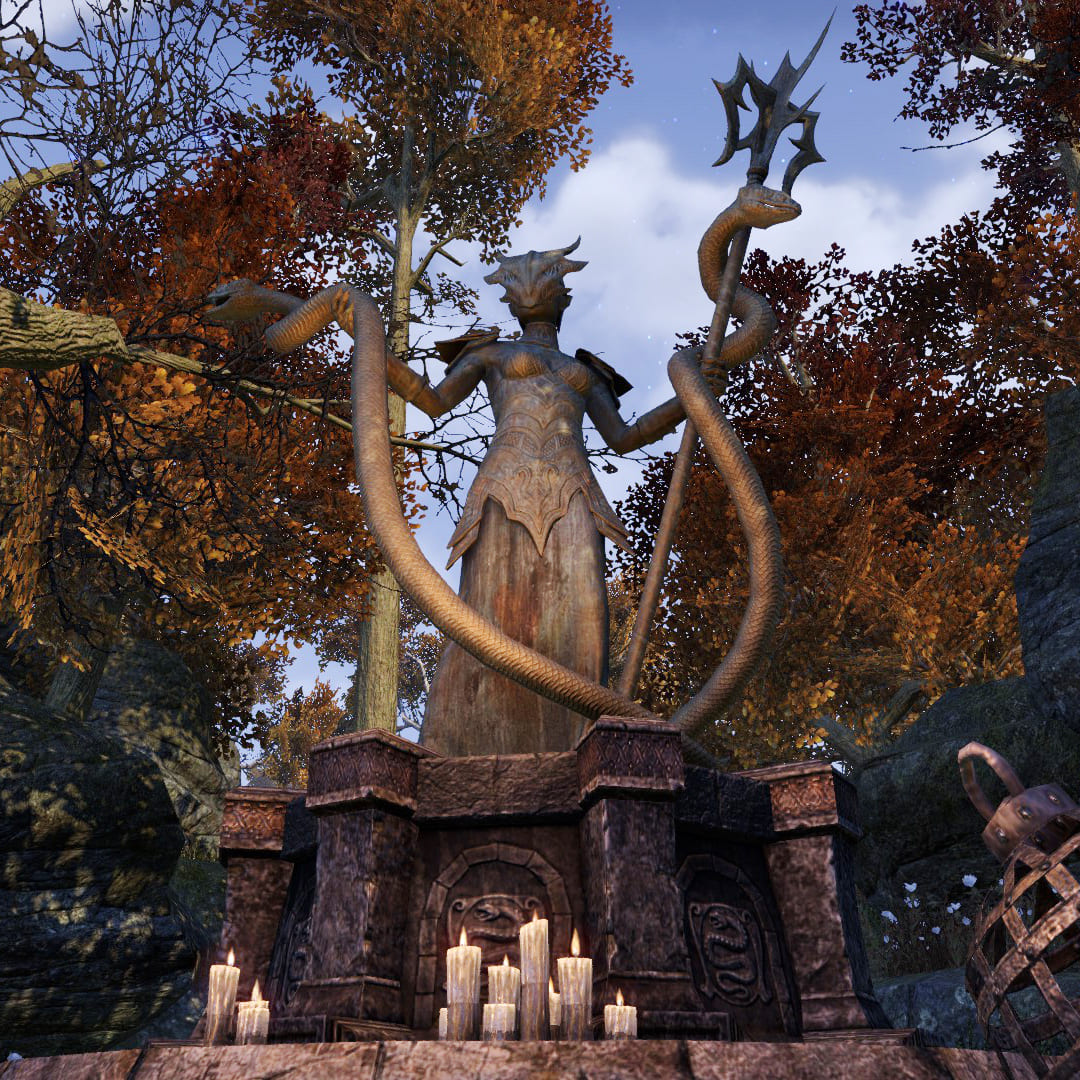 ESO ESO |
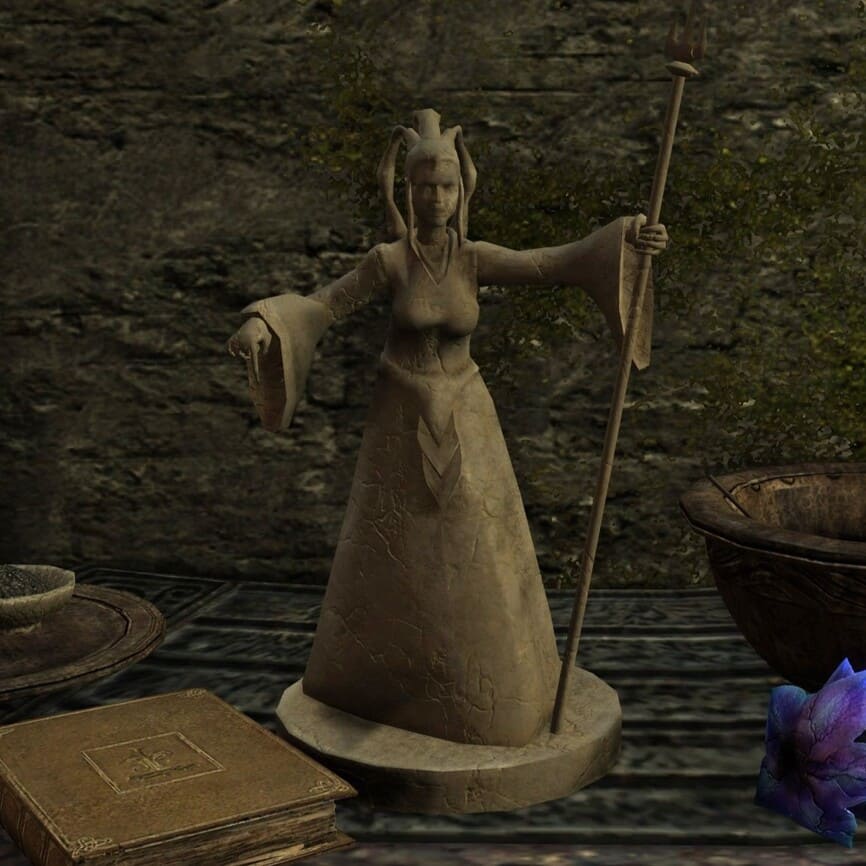 Skyrim Skyrim |
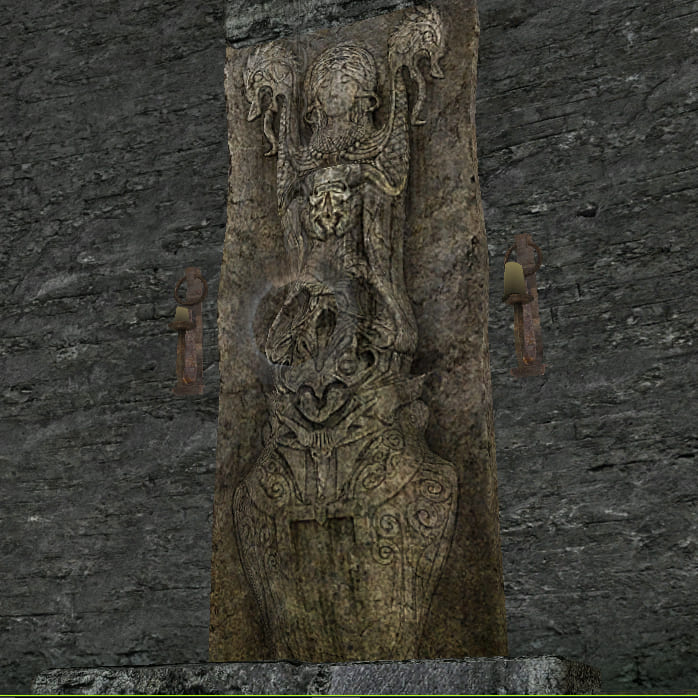 Skyrim Skyrim |
|
|---|---|---|---|---|
|
Statuary of Vaermina dating back to the mid-Second Era typically depicts her as a robed woman wearing a snake-like mask while holding a spiked staff and two serpents. Through these statues, she was known to occasionally communicate with mortals or give them instructions. These statues could be found not only in the mortal world but also in people's nightmares where they could visit a pocket realm in Vaermina's plane of Quagmire.[146][147][148] One such example dating back to at least the Three Banners War could be seen in the Nibenay Basin region of Cyrodiil, where it served as a shrine and was tended to by a group of Vaermina cultists known as the Supernal Dreamers.[149] By the late-Third Era the cultists continued to maintain the shrine, but the statue no longer bore serpent imagery. The cultists allowed individuals to solicit the Daedra lord directly, provided they possessed sufficient prowess or strength of character, and provided a proper offering.[10][150] Around this time smaller idols used in the worship of the Mistress of Nightmares could be found and conversely, some people were known to burn candles in front of serpentine figurines to keep Vaermina from infiltrating their dreams.[151][152] |
A stylized sculpture of Vaermina could be found in Nightcaller Temple during the early-Fourth Era. Located deep in the lower sanctum, it served as a shrine to the Daedra lord and depicted Vaermina as a woman flanked by two serpent hears. The temple was home to a group of Vaermina cultists before it was invaded by a band of Orcs.[153][154] |
|||
Notes[edit]
- ^ This statue of Boethia could also be found in Knife Ear Grotto, a Daedric ruin in eastern Deshaan, but it was removed at some point in 2016 after an update for reasons unknown.
References[edit]
- ^ Appearance of statue in Ashen Scar in ESO
- ^ The Three Phases of Azurah treasure item in ESO
- ^ Appearance of statue at Shrine of Azura in Morrowind
- ^ Azura's Quest quest in Morrowind
- ^ Abbot Durak's dialogue in ESO
- ^ Appearance of statue at Pariah Abbey in ESO
- ^ The Return of the Dream Shard quest in ESO
- ^ Azurite Figurine treasure item in ESO
- ^ Azura's Shrine in Oblivion
- ^ a b c d e f g h i j k l m n o p q r s t u v w x y Modern Heretics — Haderus of Gottlesfont
- ^ Azura quest in Oblivion
- ^ Ulene Hlervu's dialogue in Oblivion
- ^ Trayvond the Redguard's dialogue in Oblivion
- ^ Decree of Monument
- ^ Aranea Ienith's dialogue in Skyrim
- ^ Cavern of the Incarnate in ESO and in Morrowind
- ^ The Path of the Incarnate quest in Morrowind
- ^ Divine Delusions quest in ESO
- ^ Realm of Boethia in Oblivion
- ^ Dragonstar Arena in ESO
- ^ Shrine of Boethra antiquity codex entry in ESO
- ^ Fearstruck outfit style in ESO
- ^ The Story of Lyrisius — Bresne Smythe
- ^ Nisin Cave in ESO
- ^ a b Boethiah's Quest quest in Morrowind
- ^ Boethiah's Glory
- ^ Duma gro-Lag's dialogue in Morrowind
- ^ Tolvasa Sendas's dialogue in Oblivion
- ^ Boethia's Shrine in Oblivion
- ^ Boethiah quest in Oblivion
- ^ Sacellum of Boethiah in Skyrim
- ^ Boethiah's Proving — Anonymous
- ^ Boethiah's Calling quest in Skyrim
- ^ Priestess of Boethiah's dialogue in Skyrim
- ^ The Vile Truth of Barbas — Pelagius Habor, Council Daedrologist-in-Residence, Imperial City
- ^ Chieftain Suhlak's dialogue in ESO
- ^ War Chief Helushk's dialogue in ESO
- ^ Clavicus Vile's Shrine in Oblivion
- ^ Clavicus Vile quest in Oblivion
- ^ a b A Daedra's Best Friend quest in Skyrim
- ^ Statuette: Mora, Lord of Secrets description in ESO
- ^ The Seeker's Archive quest in ESO
- ^ Statue, Hermaeus Mora furnishing in ESO
- ^ The Lord of Fate and Knowledge Frieze furnishing in ESO
- ^ Hermaeus Mora's All-Knowing Eye Idol treasure item ESO
- ^ Ibrula's dialogue in ESO
- ^ Hermaeus Mora's dialogue in ESO
- ^ Hermaeus Mora's Shrine in Oblivion
- ^ Hermaeus Mora quest in Oblivion
- ^ Appearance of statue in Temple of Miraak in Skyrim
- ^ Black Books in Skyrim
- ^ Aspects of Lord Hircine — Juno Procillus, Academy of Chorrol
- ^ Hircine's Aspect of Guile's appearance, abilities and drops in Bloodmoon
- ^ Ivory Hircine Totem treasure item ESO
- ^ Reach-Hewn Hircine Idol treasure item ESO
- ^ The Improved Emperor's Guide to Tamriel: Northern Bangkorai and the Mountains — Flaccus Terentius, 2E 581
- ^ Statue in Shrine of the Hunt-Father in ESO
- ^ Statue in Heimlyn Keep in ESO
- ^ Statue in Ularra in ESO
- ^ Statue in Wilding Run in ESO
- ^ One Wilding Night
- ^ Nilaendril's dialogue in ESO
- ^ Hircine's Shrine in Oblivion
- ^ Hircine quest in Oblivion
- ^ a b Malacath Statue in ESO
- ^ Statuette: Malacath, Furious One description in ESO
- ^ Lacquered Malacath Totem treasure item ESO
- ^ Battered Mauloch Statue treasure item ESO
- ^ Mauloch Centrepiece treasure item ESO
- ^ Appearance of statue in Old Orsinium in ESO
- ^ Nashruth's dialogue in ESO
- ^ Flames of Forge and Fallen quest in ESO
- ^ a b c d e f Tholer Saryoni's dialogue in Morrowind
- ^ Malacath of the House of Troubles quest in Morrowind
- ^ Malacath's Shrine in Oblivion
- ^ Malacath quest in Oblivion
- ^ Giant's Grove in Skyrim
- ^ The Cursed Tribe quest in Skyrim
- ^ The Deadlands in ESO
- ^ Mehrunes Dagon of the House of Troubles quest in Morrowind
- ^ Dagon Shrine quest in Oblivion
- ^ Shrine of Mehrunes Dagon in Skyrim
- ^ The Keepers of the Razor — Silus Vesuius
- ^ Mephala, The Webspinner furnishing in ESO
- ^ Cradle of Shadows Hard Mode description in ESO
- ^ Ebony Mephala Idol treasure item in ESO
- ^ Statue in Cradle of Shadows in ESO
- ^ Triple Bust of the Good Daedra treasure item in ESO
- ^ Cradle of Shadows in ESO
- ^ Crypt of Hearts II in ESO
- ^ Dredena Hlavel's dialogue in Oblivion
- ^ Mephala's Shrine in Oblivion
- ^ Mephala quest in Oblivion
- ^ The Dreaming Cave quest in ESO
- ^ Sadara-do's dialogue in ESO
- ^ Priest Isonir's dialogue in ESO
- ^ Priest Bavian's dialogue in ESO
- ^ a b Guide to Western Skyrim: Haafingar — Imperial Surveyor Buntara Gravius
- ^ Meridia's Brilliance quest in ESO
- ^ The Break of Dawn quest in ESO
- ^ Meridia's Shrine in Oblivion
- ^ Meridia quest in Oblivion
- ^ Coldharbour in ESO
- ^ Ashalmawia in ESO
- ^ Bal Ur in ESO
- ^ Stonefire Molag Bal Effigy treasure item ESO
- ^ Seal of Molag Bal in The Great Shackle in ESO
- ^ Seal of Molag Bal, Grand furnishing in ESO
- ^ Molag Bal of the House of Troubles quest in Morrowind
- ^ Molag Bal's Shrine in Oblivion
- ^ Molag Bal quest in Oblivion
- ^ Lord Harkon's dialogue in Skyrim
- ^ Volkihar Cathedral in Skyrim
- ^ Namira statue in ESO
- ^ The Book of Daedra
- ^ Namira's Shrine in Oblivion
- ^ Namira quest in Oblivion
- ^ Namira's Shrine quest in Legends
- ^ Namira's shrine in Reachcliff Cave in Skyrim
- ^ Shrine to Nocturnal in ESO
- ^ Nocturnal's dialogue in ESO
- ^ Shrine of Nocturnal quest in ESO
- ^ Nocturnal's Shrine in Oblivion
- ^ Nocturnal quest in Oblivion
- ^ Nocturnal 's shrine in Twilight Sepulcher in Skyrim
- ^ Nocturnal 's shrine in The Ragged Flagon in Skyrim
- ^ Filbert Cienne's dialogue in ESO
- ^ Zaan the Scalecaller's dialogue in ESO:Dragon Bones
- ^ Scalecaller Peak in ESO
- ^ Bal Sunnar in ESO
- ^ Saresea's dialogue in ESO
- ^ Bal Sunnar in the future in ESO
- ^ Unstuck From Time quest in ESO
- ^ Peryite's Shrine in Oblivion
- ^ Peryite quest in Oblivion
- ^ Sanguine's Shrine in Oblivion
- ^ Sanguine quest in Oblivion
- ^ Zaintiraris loading screen in ESO
- ^ Sheogorath of the House of Troubles quest in Morrowind
- ^ Sheogorath's Shrine in Oblivion
- ^ Sheogorath quest in Oblivion
- ^ A Strange Door quest in Shivering Isles
- ^ Wabbajack in Skyrim
- ^ Events of Saints and Seducers creation in Skyrim
- ^ Various locations in the Shivering Isles
- ^ Dark Ministrations
- ^ Godrun's Dream quest in ESO
- ^ Hozzin's Folly quest in ESO
- ^ Vaermina's Shrine in ESO
- ^ Nocturnal's Shrine in Oblivion
- ^ Dreams of the Dead quest in Skyrim
- ^ Charm of Protection from the Night treasure item ESO
- ^ Events of Waking Nightmare in Skyrim
- ^ Erandur's dialogue in Skyrim
Note: The following references are considered to be unofficial sources. They are included to round off this article and may not be authoritative or conclusive.